Parts One and Two set the stage for this, the last week of the trip.
Day 15: Worland to Dubois, WY, 159 miles
With an overnight low of only +80F, I wake up early and am pedaling by 5:15am, trying to make miles before it heats up too much. Hotels simplify the getting-going-in-the-morning process a great deal. No sleep system to pack up, just slam a coffee and get out the door. My goal for the day is to ride almost 160 miles to my sister Katrina’s house in Dubois, at the foot of the Wind River Range on the other side of the state.
A couple hours later I’m in Thermopolis and ready for breakfast. Sitting here, tapping out a recounting of this particular morning on my keyboard, more than two years later, my instinct is to simply brush over those first couple hours of riding that day. But part of me feels like those two hours, however mundane, are so emblematic of the magnitude of a bike tour like this as a whole.
On the surface level, those ~30 miles between Worland and Thermopolis were completely unremarkable. A trafficked but not unreasonably busy state highway with a wide enough shoulder to feel safe (8-foot? 10-foot? Not sure.). Gently rolling to flat topography. Uninteresting agricultural scenery. Pre-dawn to sunrise light. No physical problems.
But mentally I am struggling. It’s too early to be interested in podcasts or music for distraction. The psychological weight of an impending long day in the saddle is heavy. But that’s stupid. On a tour like this, every day is a long day in the saddle. Some background-level anxiety about the forecasted temps in the upper 90s contributes to my general dread for the day ahead. Questions about whether I should try to take the potentially private (internet information is almost non-existent) Blondy Pass short-cut over the Owl Creek Mountains through the Wind River Indian Reservation are bouncing around in my head, too.
But, basically, I am just simply overwhelmed by the tedium of it all. So, I keep pedaling and narrow my focus to getting to Thermopolis where I can reward myself with a gas-station breakfast stop. A sit-down joint is out of the question—too many miles to cover today if I am going to make it to my sister’s house before dark.
These moments of low motivation are one of the great challenges of bike touring. There’s too much time to look inward and ponder the why of it all. That question is easy to answer when energy is high, one’s surroundings are inspiring, or the trail is challenging enough to keep you engaged. It’s in those completely unsexy, uninspired, rote, in-between moments that the real challenge comes, when there’s nothing really to work against except the magnitude of just how much further you have left to go. The humdrum middle where the only way out is through.
Nevertheless, of course, I finally make it to Thermopolis. A quick scan on my phone turns up a coffee shop—Jackrabbit Java just off the main drag. A real coffee sounds like a treat. The coffee itself ends up being forgettable—a heavily overwatered Americano—but standing in line is one Hank Mustang. I only know that his actual first name is Henry, and that I had met him briefly a decade previous when he was crewing for Dylan Bowman at the Leadville 100. I was spectating that year—after having been on crutches for much of the previous two months—and DBo placed second to Ryan Sandes. Henry is road-tripping back north to Montana after a weekend of crewing for DBo again at the Hardrock 100 (where he notched a career-highlight second place to Francois D’Haene).
Henry’s and my interaction is brief, and I don’t remember many of the specifics about it, but our short and largely mundane conversation completely turns my head around. I leave Thermopolis deciding to commit to the sure thing—the highway through the Wind River Canyon and around the southern end of the Owl Creek Mountains—and with fresh motivation for the mostly paved 130 miles I still have left to reach Katrina’s.
Late in the afternoon, with less than 10 miles to go to Dubois, the persistent downriver headwind that I’ve been working against all afternoon turns into a comical gale as a storm front pushes through the area, complete with lightning and lashing rain. This trying coda to the ride only makes dinner that evening with my sister, her husband, Chris, and my nephews that much more satisfying.
Day 16: Dubois to Green River Lakes Trailhead, 71 miles
I sleep in until 6:30am or so and have an indulgent, leisurely morning catching up with Katrina over several home-baked scones and mugs of coffee, doing laundry and generally basking in the creature comforts of normal life. I’m a bit taken aback at how restorative and comforting it is to be in the presence of family. It feels like the weeks on the road have stripped away some of my emotional armor, making me more open to not only giving and expressing love but also receiving it. It’s a joy to see my nephews, Emil and Miles—eight and six years old—growing into being such energetic and curious humans.
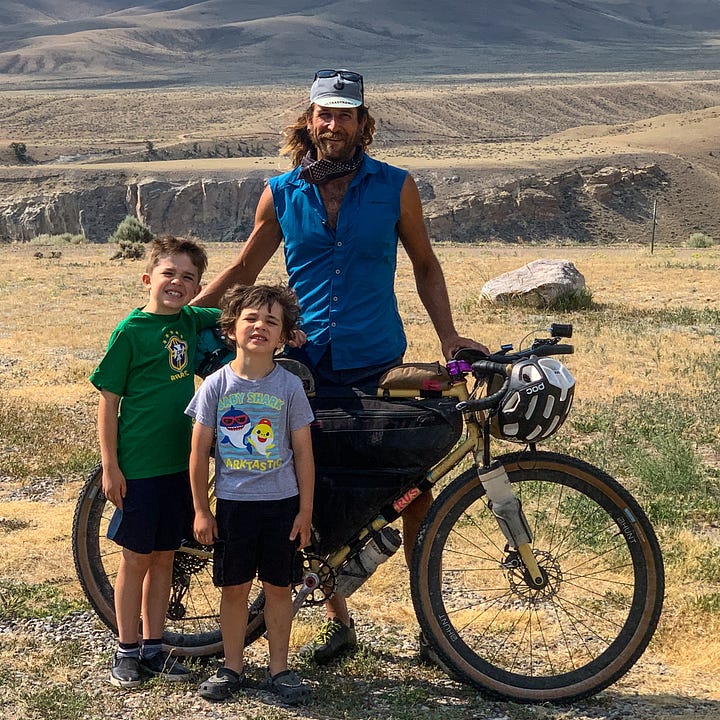
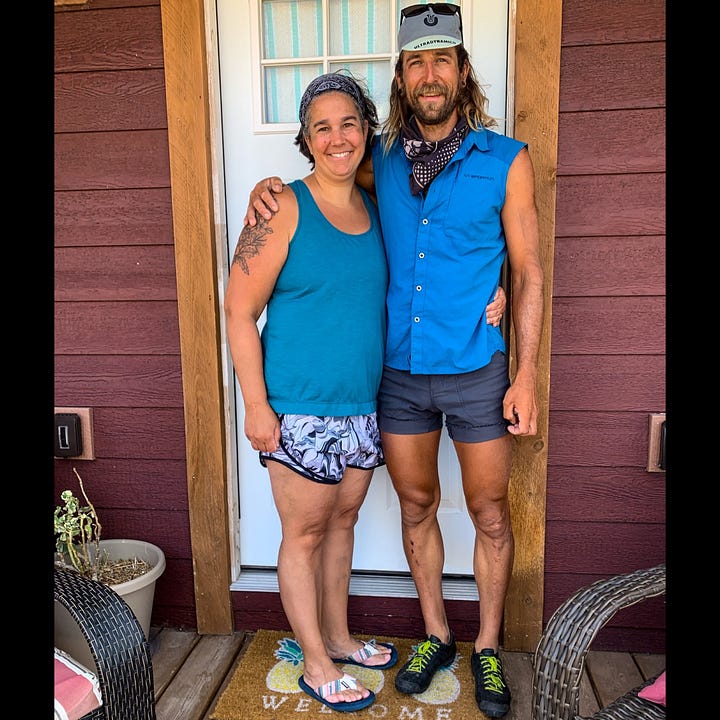
I finally start rolling towards Union Pass a bit after 10am, by far my latest departure of the whole trip. It’s no problem, though. Today is a comparatively short day of riding to get over to the Green River Lakes Trailhead on the far side of the Wind River Range, and I’m relishing the easier agenda before my planned run up Gannett the next day.
When I turn onto the gravel of Union Pass, I’m re-joining the Great Divide Mountain Bike Route (GDMBR), which I will follow from here all the way back to Steamboat Springs in Colorado. It’s a hallowed and legendary route in the bikepacking world, and all of it from Pinedale to Steamboat will be new for me.
My buddy Fred catches me up on Union Pass in his van and leapfrogs me most of the day, grabbing photos. I’ve worked with Fred many, many times previously, and he’s an experienced ski mountaineer, cyclist, climber and runner himself, so our interaction is easy, but after so many days on the road I’m just as comfortable—maybe even moreso—passing the miles inside my own head. The approach to the trailhead in the late afternoon is a dramatic one with giant mountains shooting up on the sides of the valley, and I snuggle into my bivy that night looking forward to the next day’s run.
Day 17: Gannett Peak plus Pinedale, WY, 51 miles
I wake up at the Green River Lakes Trailhead feeling unusually rested and excited at the prospect of the longest run and most remote summit of the whole trip. I have been here once before, nearly a decade previous.
In September 2012, Katrina and Chris were married in Dubois. I was living out of my pick-up truck, so staying on in Wyoming for a couple of days after their wedding was an easy decision. Mid-September starts being a bit late in the season for summer conditions in the Teton and Wind River ranges, but the region had been graced with an unusually long, stable window of high pressure—there was no significant snow in the high country yet—and I was determined to put it to good use.
The day after their wedding, I went for an obligatory run up and down the Grand Teton. The cracks and chimneys of the Owen-Spaulding route were unexpectedly filled with ice and the frigid wind on the summit mandated a jacket and gloves. It was a rude reminder that it was only a couple of days until the autumnal equinox. Nevertheless, despite some extra care needing to be taken on the technical portions, it was an otherwise uneventful late-season romp on one of the most iconic peaks in the country. A beefy warm-up on demanding yet familiar terrain for what I had planned the next day.
Upon finishing, I hopped in my truck and drove the 100 miles south to sleep at the GRL Trailhead for an attempt on the Gannett Peak FKT the following morning. I remember it being quite a cold night with the temperature dropping well below freezing. Even so, after brewing up a couple mugs of coffee on my tailgate, I set off in what I think back on now as shockingly minimal style: shorts, shoes, wind jacket, a non-GPS wristwatch, a dozen energy gels and a digital camera with a photo of the paper map on it. That’s it. No shirt, no socks, no pack nor even a waist belt, no water filter, no cell phone let alone a personal locating beacon (SPOT tracker, Garmin InReach, etc) of any type. I think my sister had a vague idea of my plan, but that was it.
I had a great run. Onsighting a route and peak as complex and remote as Gannett is no easy task, but I remember having one of those days where the body and mind are working perfectly in sync. I think I even had two gels to spare at the finish. I took almost four hours off the previous FKT with my 8h46m roundtrip time. I completed most of the drive back to Boulder that evening still, so that I could go for a run up Longs Peak the next day. This also capped a post-Leadville 100 four-week block where I had 41,000-45,000’ of vertical gain each week (which was actually a step down from the 50k’ weekly totals I’d been accumulating that summer). Ten days later I finished second—five minutes behind Kilian Jornet—in a rugged 53 mile ultramarathon in the Spanish Pyrenees. Stuff like this comes easily in your late-20s.
While I’m astounded at my energy, physical durability and pure fitness from that summer a decade ago, what really sticks out to me now is how I was living with a truly singular focus. No apartment, no steady girlfriend, no perceptible acknowledgment of a responsibility to anything or anyone beyond myself, to be sure. But also, athletically, I was primarily only a runner. I had missed the previous summer season with a broken leg, so I spent the summer of 2012 at least subconsciously determined to make up for it.
While running—indeed, racing—was absolutely top of mind for me, that broken leg had shifted my perspective on mountain movement significantly, and the 2012 summer was the first season where I was putting that perspective shift into practice, seeking out more and more technical routes where climbing skill and experience were required. Nevertheless, foot travel volume—now with more of a focus on vertical gain rather than the mileage I’d pursued in the 2000s—was paramount.
Looking back on my training log from that season, I honestly find the volume and sheer fervor with which I consumed mountain terrain to be shocking. Like, I can’t believe I did it. Part of me looks at that time with some nostalgia—ah, such halcyon days, why can’t I do that now? Because, we change. And that’s a good thing. There’s a lot about that period in my life that—despite being impressed by the athletic side of it—I find to be sad.
I think it’s ok, perhaps even appropriate, to live selfishly and monomaniacally in your 20s. Your brain is only recently fully formed, you’re in the process of figuring out who you are and what is important to you. Age, although diminishing one’s recovery abilities, at least provides perspective. It becomes obvious that factoring in other humans—acknowledging and nourishing meaningful relationships—is fundamental to a life well lived. Eventually, glimmers of one’s own mortality even sneak in.
In 2012, I was in the middle of a 12-month period where I traveled to every continent except Antarctica as part of my new career as a professional runner. I was also newly-single; my girlfriend of six years and I broke up just before Christmas. I think this triggered in me a kind of low-grade nihilism that affected my decision making at the time. That is, all of my decisions revolved around me. A bit of this is necessary to reach the top of any pursuit. All of my significant hill-climb PR’s in Colorado came that summer. And as my performance at the Cavalls del Vent 85K in Spain that fall validated, I was at the top.
But such myopic, self-centered mania is not sustainable, thank goodness. Conversely to a decade previous, my most potent source of strength in the face of the daunting physical challenges on this current trip is not some deeply held desire to prove myself with an FKT or a top race result but rather the love and support I feel for and from my partner, Hailey. As I sit snuggled in my sleeping bag in pre-dawn light, sipping cold instant coffee and eating a frozen burrito, I’m not harnessing my energy for some aggressive attempt at re-claiming an FKT. Instead, I am grateful for the way the trip has unfolded such that I feel ready to take on such a big, committing mountain adventure, and I want to be sure to do it as efficiently yet responsibly as possible so that I can eventually get safely back to Colorado to be with Hailey again.
But I am still going to try. Old habits die hard.
On the 12-mile flat approach run up the Green River valley I keep my foot on the gas, trying to move quickly while still pacing myself for what will inevitably be a very long day.
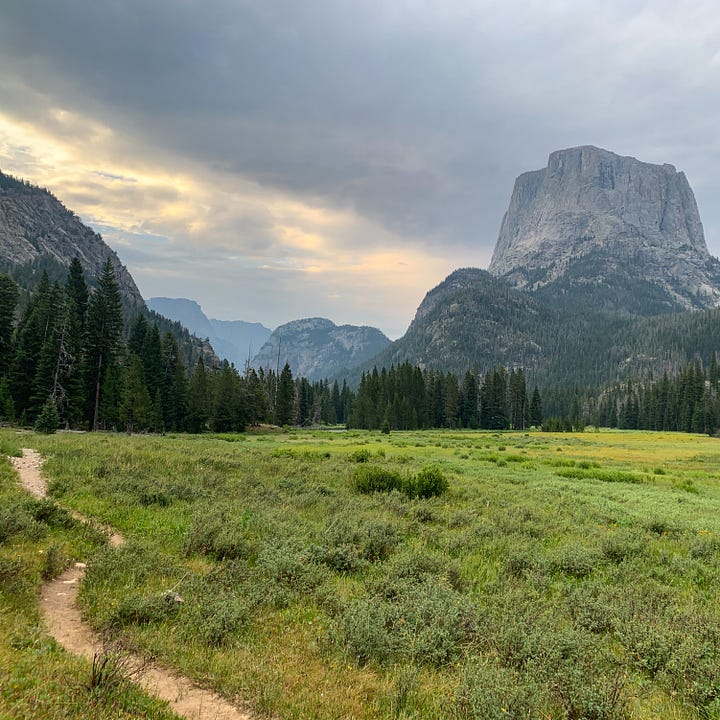
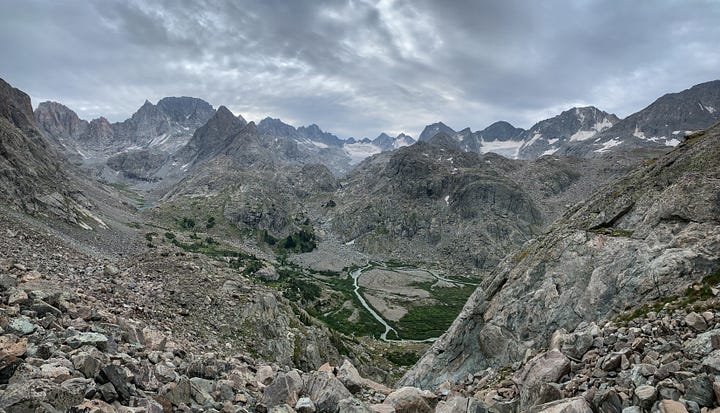
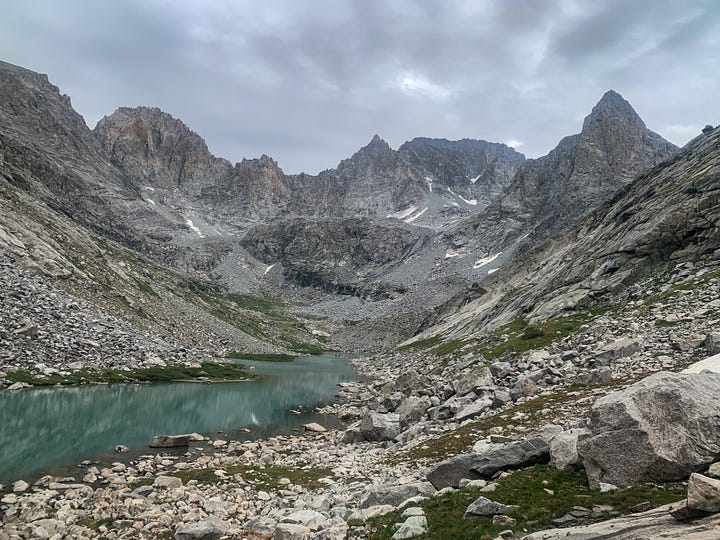
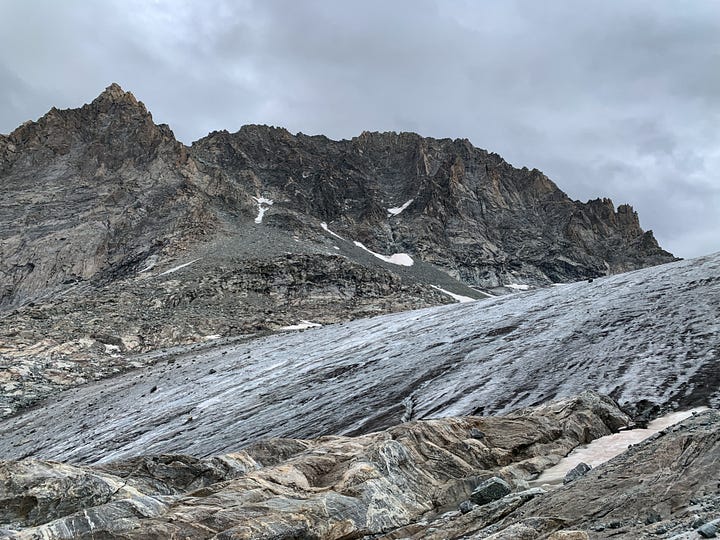
I cover this section well—7min faster than during my record run a decade earlier—but then find the crossing of the Green River to be much deeper than I’d remembered. From there the bushwhacky, off-trail rock hopping that defines the Tourist Creek route truly commences and I just do the best I can, reaching the Tourist-Wells Creek divide at exactly the same time as in 2012. The most direct line below Gannett’s western aspect requires crossing a portion of the Minor Glacier—a little intimidating in only running shoes—but it is juuussst low-angle enough to be fine, and I am soon scrambling up the final 1500’ of Gannett itself.
From the glacier, it’s choose-your-own-adventure to the summit, the easiest route being a hideously loose scree gully. I soon become disgusted with this, however, and instead quest up a climber’s-right, low-5th class spine of relatively solid rock, fingers crossed that I won’t reach an impasse that I’m uncomfortable onsight soloing. Ultimately, this choice is certainly more fun but probably a bit slower, and I pop out on the summit at 4:49, 3min behind my split from nine years ago.
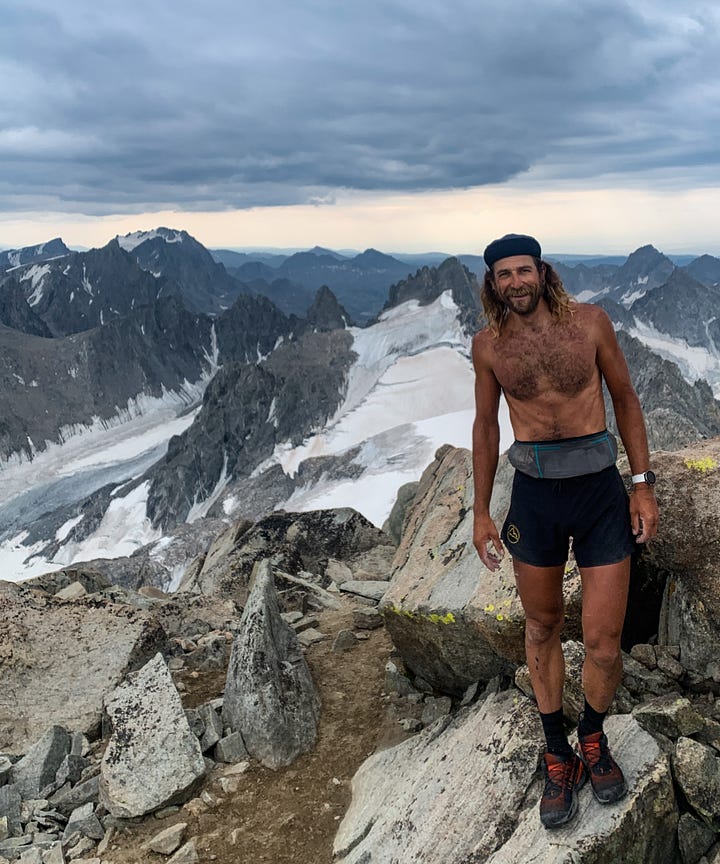
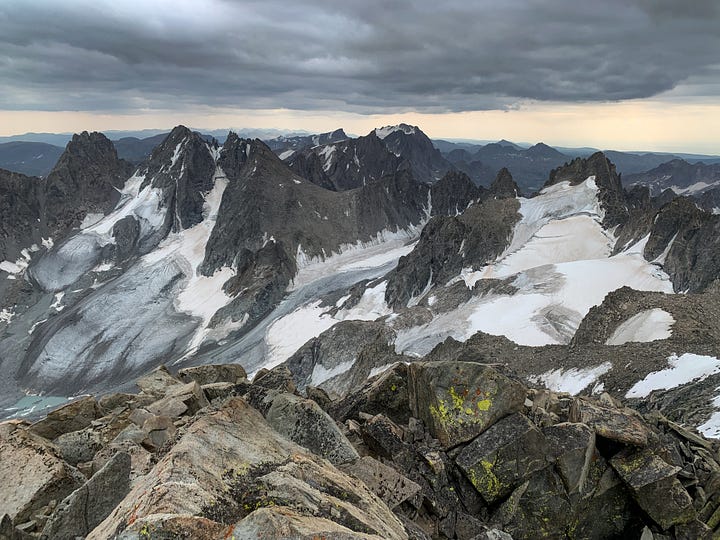
There is a guided party on the summit who have ascended the much more popular Bonney Pass/Gooseneck Glacier route, and I have them hastily snap my photo before beginning the descent. The skies have been heavy and gloomy all morning, providing ideally cool temps, but they now seem to be threatening imminent precipitation.
Sure enough, a few minutes after starting down it begins sprinkling benignly, so I don’t give it much thought, but then a couple miles of rock-hopping later—below the western slopes of Mt Solitude—the skies open up in earnest. Dang it. I don’t care about getting wet, but now all of the boulders that I am hopping across are saturated and slippery, making for truly treacherous footing. At first I think I can continue to push on at FKT intensity, but after a few slips I finally make a mistake with consequences. My foot skates on a patch of lichen and in catching myself I incur a deep gash on my shin and painfully strain the rotator cuff of my right shoulder.
The FKT attempt is officially off. I just can’t risk falling again in this jumble of refrigerator-, car-, and van-sized boulders, especially while so deep in the backcountry. Unlike nine years ago, I have a tiny Garmin InReach Mini satellite device with me, but I really don’t want to have to use it. Thankfully, my shin clots quickly, but my shoulder is nearly useless as I tentatively gimp my way down Tourist Creek to re-wade the Green River and run the 12 miles of trail back out to the trailhead. Without the focus and purpose of chasing a record the final hour becomes an interminable grind. I run out of food and water, of course, and seriously question any silly notions I’d held about possibly running the Leadville 100 the following month. Running that far sounds impossible.
Back at the trailhead, I take a quick dip in the lake to wash off the trail salt and dust. Just as I do so, an errant stormy squall blows through with high winds and some precip. I feel stuck. I’ve just completed a 38-mile/10-hour run and am sorely in need of food, but I only have a few hundred calories on my bike. Fresh from the lake, all I want to do is mow a pizza pie or cheeseburger or three, crawl in my sleeping bag and take a nap, but I can’t responsibly do so with the meager sustenance I actually have with me. There’s nothing to do but fill my water bottles and ride the 50 miles into Pinedale—the closest services—before grocery stores and restaurants start closing.
A part of me can’t believe that my day of endurance is only partly over—I deserve a rest and some culinary rewards!—but after just a few turns of the pedals another part of my brain clicks back over into action mode and I reset my objective from finishing the run to getting to Pinedale. Somehow, with this change in mindset successfully achieved, I don’t even feel that bad.
Eventually the road mercifully transitions from bumpy gravel to smooth pavement and a dozen miles out from town one of the best sunsets of the whole trip paints the sky in deep hues of purple and pink. I skate into Pinedale’s Ridley’s Market with 15min to spare before closing and fill a couple grocery bags to take with me up to the baseball fields for a trusty dugout bivy. I’m a bit bummed to find that the team bench is not truly a dugout, however, just a simple corrugated steel roof with no walls, and blustery winds are blowing rain in through the chainlink fence. Dang it.
I locate the facility’s restroom, but it’s locked. Man, I really need some cover and restorative sleep. Out of desperation I punch 1-2-3-4 on the door’s combination lock and it opens onto a spacious and clean room. No fucking way! With no windows, and safely locked inside with my bike, I sleep like the dead.
Day 18: Pinedale to the Great Divide Basin, 120 miles
I also awake like the dead. My injured shoulder has stiffened so much overnight that I can barely sit up in my sleeping bag and am doubly slow packing everything up. I FaceTime Hailey from the sleeping bag, and I don’t even mount my bike to roll downtown for a sit-down breakfast until 8:30am. The sun has been up for hours. No matter, with Gannett successfully completed, a great psychic weight has been lifted. Although my shoulder and shin have me feeling bruised and battered from my boulderfield fall, my ever-questionable achilles tendon seems to have survived the longest run of the trip without protestation.
Heart & Soul Cafe on Pinedale’s Main Street delivers. I order the bike-tour usual—embarrassing amounts of eggs, french toast and coffee—and cop an oversized breakfast burrito for the framebag. A dozen paved miles later I make another stop in Boulder, WY—not much more than a motel and a gas station—for last-chance supplies before committing to the nearly service-less stretch between there and Wamsutter, 175 miles away.
There are a couple of southbound GDMBR cyclotourists also stocking up at the convenience store, and we trade obligatory pleasantries. I sense in myself, however, an annoying and puzzling lack of a desire for kinship with these fellow travelers. Despite having previous and unexpected positive chance encounters, I don’t know what it is about my brain, but the last thing I want right now is a riding companion. Even on this, the most remote section of the whole route. Perhaps especially on this, the most remote section of the whole route. On a long ride like this, I think I find company—at best—a neutral presence. Most of the time, however, I’m so deep inside my own head that engaging with another human is either distracting and/or requires too much energy. Obviously, I’m an introvert.
The next 75 miles to Atlantic City are a joy. Wide open country with big rollers and, much to my delight and everlasting gratitude, a marked cross-tailwind. Unfortunately, the smoky air significantly obscures my last views of the Wind River Range, but overall I’m pleased to make good time after my slow morning. I roll into the old mining hamlet of Atlantic City in late afternoon—about 5:30pm—and decide to track down an early dinner. Atlantic City is the launching point for perhaps the most legendary feature on the GDMBR—the Great Divide Basin.
The Basin is where the Continental Divide actually splits into an eastern and western branch for 100 miles or so before it rejoins into a unified continental watershed near the latitude of Interstate 80 in southern Wyoming. It is typified by expansive, wide-open horizons; not a single service, nor even a paved road; herds of mustangs; show-stopping, peanut-butter mud if it rains; and basically no water. The remoteness and utter lack of shelter from the elements can be intimidating, but the feeling of being truly Out There has few peers in the Lower 48. I’ve been looking forward to it the whole trip.
Atlantic City has two dining establishments, located next door to each other—the Mercantile and the Miner’s Grubstake. I sit down at the Mercantile for a cheeseburger and fries dinner, and upon finishing wander next door. This is clearly the thru-hiker’s hangout, the main draw probably being the WiFi. I log-on myself for a last-minute check of the weather—zero chance of precip, a continued cross-tailwind that will switch to a headwind mid-morning tomorrow, and another +100F day on tap. It’s relatively early, 7pm or so; I figure I’ll ride a few more hours, until I get sleepy, taking advantage of the tailwind, bivy out in the Basin, and get rolling early so as to beat the heat and the switching headwind as much as possible the following morning.
Just as I’m about to leave, one final text comes through, with a photo. It’s from my buddy, Danny. He’s just crumpled the downtube on a bike that I had sold him earlier in the year. Oh no! As I pedal out of town loaded down with 4L of water and a 100 miles worth of snacks I am keenly aware of how much the frame is flexing and I try to ease my rig as gently as possible over any rut or pothole in the road. It will be a looooong, hot, thirsty hike out of the Basin if I break my frame out here!
Immediately upon leaving Atlantic City, I’m in it. The Basin. The smoky horizons only add to the Last Man On Earth vibes of the scene as I pass simple signposts along the double-track indicating that this was part of the Oregon Trail. The landscape can’t have changed much in the past 150ish years. The setting sun is an eerie red orb and soon there’s an even more brilliant red full-moon rise to complement it. As the wind gradually dies, I settle into the peaceful solitude of the place. By 10pm, I’m ready for bed; I don’t even bother to pull over. I lay out my mattress and bivy and fall asleep in a sandy lane of the double-track with no concern for any vehicular traffic.
Day 19: Great Basin to Brush Mt Lodge, 144 miles
I’m pedaling before 6am after what feels like an extraordinarily restful sleep, even with the full moon shining like a spotlight all night. No cover out here except the sagebrush. Nevertheless, the Basin seems to agree with me.
As the sun is rising, I stop pedaling to put in my earbuds and queue up an episode of Fresh Air. Terry is interviewing Questlove about the documentary he’s directed about the 1969 Harlem Cultural Festival, Summer of Soul. I’m minding my own business, easing into the rapidly warming day, out of the saddle, pumping up a little roller, when a clip of The 5th Dimension’s “Medley: Aquarius/Let the Sunshine In” is spliced into the podcast production.
Something clicks. I’m overcome with intense emotion. Smiling but weeping. No explanation. I don’t feel anything like traditional happiness or sadness, just pure euphoric catharsis. There’s no point in continuing to listen to the podcast; instead I queue some of my favorite songs— “Shapeless and Gone” by Porcelain Raft, “Stadiums and Shrines II” by Sunset Rubdown, “Uncast Shadow of a Southern Myth” by Parquet Courts, “A Hymn” by IDLES, “A Private Understanding” by Protomartyr, “Vox Celeste” by Deerhunter, “Yellow Room” by Pile, “Inside Madeline” by Swans, “A Year From Here” by Lea Porcelain, “We’re An American Band” by Yo La Tengo, “Blind” by Michael Gira all just for starters (I could go on and on and on, and I do)—and absolutely mash on the pedals for most of the next two hours, all while bawling my eyes out. A herd of wild horses appears off to my left and breaks into full gallop, raising a trailing cloud of dust. If a stegosaurus popped into view I wouldn’t be surprised.
I’ve had experiences like this before, albeit for only a few minutes at a time, not hours. I don’t know what it is, but, for me, it seems to be triggered by some combination of physical exertion, caffeine and music. As far as I can tell, 20th-century psychologist Abraham Maslow (he of “hierarchy of needs” fame) referred to these types of episodes as “peak-experiences” where an individual has a profound feeling of love, connectedness, joy, unity, self-actualization etc., etc. I can say that, despite my deep resistance to such a hackneyed term, the overwhelming emotion for me is a kind of poignant gratitude. The gratitude is a result of feeling in the right place at the right time doing exactly what I’m meant to be doing. But the triggering of one of these moments for me seems completely involuntary.
It is also not what I would characterize as the more popular concept of “flow-state.” For me, I’ve always attributed that to an episode of greatly heightened focus, coordination and fatigue resistance. This is something that I can induce with enough effort and care in a broad swath of activities—most reliably while climbing or running, but also while cycling, skiing, mountain biking, or even writing. Maslow’s so-called peak-experiences, on the other hand, are something I’ve only experienced while cycling and skiing (well, skinning uphill, to be precise). I explain this by the fact that 1) I will frequently listen to music while doing those two activities, and 2) they are highly physically intensive but also quite linear, mechanical motions that with enough practice require very little focused skill to perform well, i.e., my attention and emotion can wander, usually inward.
No matter how one describes or defines this type of experience, the Basin is absolutely a highlight—maybe the highlight—of the entire trip.
After 35 rampaging miles or so, the doubletrack of the Basin dumps out onto a wider, properly maintained gravel road (accessing oil and gas wells) and the spell gradually breaks. It’s another 30 miles to Wamsutter and services, now into a strengthening southern headwind, and cycling is once again everyday and workmanlike, not infused with all the meaning and magic of the universe that the last two hours have comprised. And that’s ok. By definition, peak-experiences aren’t sustainable. I’m just grateful to have had one, and in such a magnificently desolate place.
I roll into Wamsutter shortly after 10am and it’s already blazing hot. A Love’s Truck Stop provides a sweet, air-conditioned reprieve and an extended brunch before the afternoon shift aboard my Evasion Lite. The crush of Interstate-80 travelers is ameliorated by the fact that my crossing of the Basin was under basically the best possible conditions I could’ve hoped for.
The afternoon is a trudge into a hair dryer headwind, but eventually the sun relents and with it, the wind. I ascend the more than 15mi climb (“Kirsten’s driveway”) from Savery up to the legendary Brush Mountain Lodge in northern Colorado under another rising moon. There are a handful of GDMR riders staying at the lodge, but after a warm welcome from Kirsten I’m once again in my head and feeling solitary. I roll out my bag and bivy on the lawn and set an early alarm. I’ve had a heckuva day, but I think I’m starting to be ready to be home.
Day 20: Brush Mt to Granby, CO, 137mi
The riding out of Brush Mt Lodge is gorgeous, especially under the pleasantly cool morning air and a lazily rising sun. As I push my bike over the final steep pitch of Sand Mountain I try to envision what it would be like to be up here in mid-June in the middle of the night, questing through a snowstorm halfway through the Tour Divide, like what happened to the race leaders in the 2019 edition, the last time the race was held (as of the date of this trip, July 2021). In its current idyllic mid-summer, early-morning condition, it’s hard to imagine.
A couple hours later I’m rolling into the seemingly ever more bourgeois streets of Steamboat Springs. After a quick lunch, I tackle Buffalo Pass. That verb doesn’t feel accurate. I survive Buffalo Pass. At first, it’s not too bad. The road climbs relentlessly, but that’s no problem. My labored spinning is powered by multiple episodes of Rob Harvilla’s outstanding and hilarious 60 Songs That Explain the 90’s podcast. Episodes on Weezer and Third Eye Blind, specifically. Eventually, however, the road surface degrades to steep, loose, cobbly dogshit, and I spend the last hour of the climb in my lowest gear, only not walking the extended 10-12% grades out of sheer stubbornness.
The swooping gravel descent on the far side of the range drops me into the valley of the headwaters of the North Platte River. Perhaps appropriately (given the Platte River’s eventual Great Plains significance), a spectacular wind is blowing up the valley, making my progress slow and sketchy with near-constant cross-gusts. Once I hit the pavement taking me over Willow Creek Pass (and the Continental Divide), I am finally back on familiar ground and the long descent of Willow Creek into Granby is almost a trip down memory lane, as Hailey and I toured this region of Colorado two years previous. Last year (2020), though, the largest wildfire in Colorado history ravaged this zone; it’s sobering to witness the incinerated remains of the once-thick forest.
My final bivy of the trip is another trusty dugout in the center of Granby—I want to be as near as possible to the coffeeshop the next morning.
Day 21: RMNP & Longs Peak, 117mi
The western side of Trail Ridge Road in Rocky Mountain National Park is one of my favorite climbs anywhere and on this morning my legs are powered by last-day-of-the-trip giddiness. I dispatch the 4000’ climb from Granby to the Alpine Visitor Center on the Continental Divide with minimal effort. After three weeks, I’m in such a rhythm with the bike that such a big ride just feels like another morning, no big deal.
The descent into Estes Park is fast, if heavy with tourist traffic, and I head straight to my regular Estes haunt, Kind Coffee, for a mid-day sandwich and a topping off of the caffeine stores. It’s another 10 miles and 2000’ of climbing to get up to the Longs Peak Trailhead, and as I make my way up Fish Creek Road the skies over Longs look a bit dark and ominous, not uncommon for a mid-summer afternoon on the Front Range. No matter, nothing is going to stop me on this, the last summit; I’ll happily wait out a quick storm at the trailhead or treeline if need be. This kind of confidence is only possible with Longs being my home mountain. Today will be my 92nd ascent of the peak—there aren’t many conditions I haven’t experienced up there.
At the trailhead, though, things look good, and after stashing my bike I start running up the trail at the decidedly unconventional hour of 2:30pm with 65 miles of pedaling and an alpine crossing of the Continental Divide already in my legs. Caffeine and general smelling-the-barn adrenaline have me feeling so good, in fact, that, at treeline, I spontaneously decide to head up the more sustainedly technical and dramatic east face Kieners Route, rather than the shortest, quickest north face Cables Route that only has a couple short pitches of technical scrambling.
My maiden ascent of the Kieners Route on Longs Peak was almost a decade ago, in June 2012, only a week after my very first ascent of the mountain itself via the standard but tediously sinuous Keyhole Route. After my 2012 spring of progressing my scrambling experience in Boulder’s Flatirons, I was keen to translate my newfound appetite for technical terrain from the lowlands to the alpine. My friends Buzz Burrell and Peter Bakwin—already mentors for me in the let’s call it “alternative-running” space—invited me on an outing up Kieners.
Kieners Route is notable in that it is a proper mountaineering route, not a simple walk-up on a Class 1 to Class 3 trail like most 14er routes in Colorado. It navigates Longs’ imposing and sheer east face by climbing a steep snow couloir (Lambslide) to access a vertiginous and wildly exposed traversing ledge system (Broadway) to where the official Kieners Route actually begins. From Broadway, Kieners goes up, flirting with the edge of the Diamond—the notorious 1000’ alpine big wall–-by climbing several pitches of 5th-class chimneys and cracks before finally topping out on the summit of Longs. Graded at a moderate 5.4, Kieners is a reasonable solo, but the exposure and wild position make it unnerving and untenably consequential without a rope for many.
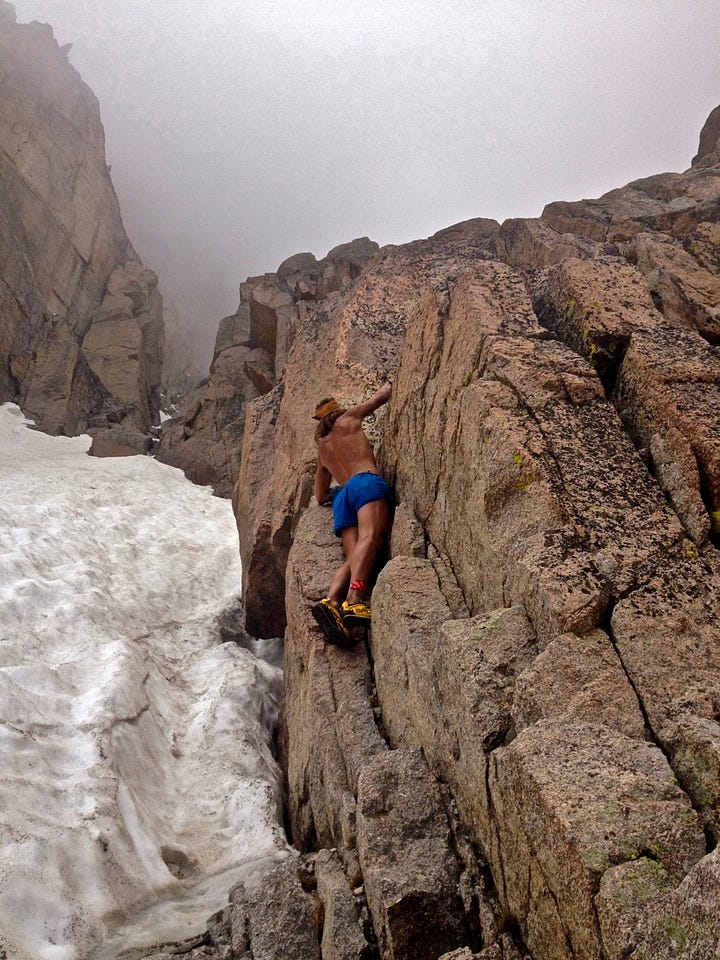
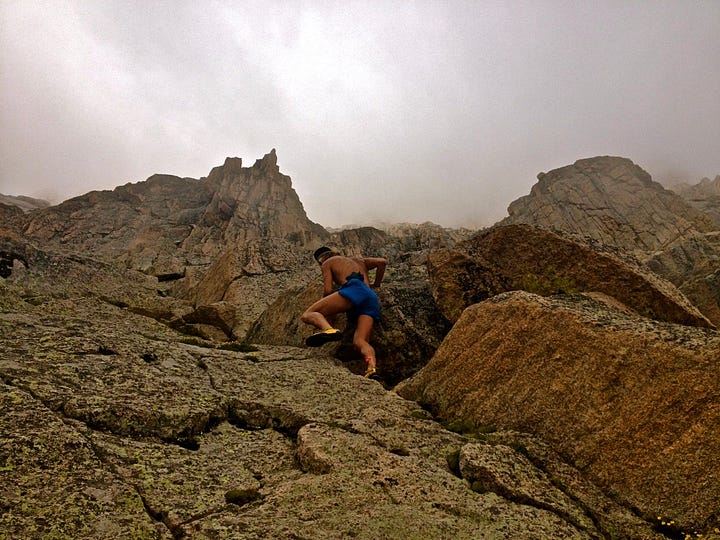
It would not be hyperbolic to say that my initial outing on Kieners with Buzz and Peter was life-changing. It was empowering to realize that I comfortably possessed the composure and skill necessary to access such seemingly inhuman positions in the mountains without the extra weight of a rope and climbing rack. Glimmers of the potential for this kind of mountain movement had been apparent in my Flatiron outings, but now, here in the alpine, a whole new world was opened to me where running fitness could be combined with technical climbing competency to devise mountain adventures that I had only ever dreamed of before. I obviously wasn’t breaking any new ground in an absolute sense, but it was all very new and unexpected to me, and realizing that our own capacity and agency is so much greater than we previously thought is all that really matters in the end.
I was hooked. So much so, in fact, that I went back the very next day with my buddy Joe (“you have to see this!”), and then the day after that I returned solo, setting a still-standing car-to-car FKT on the route. There aren’t too many turning points in a person’s life that one can confidently identify, but that day on Longs with Buzz and Peter in 2012 was definitely one of them for me.
Obviating the need for crampons and an ax to ascend Lambslide, I instead scramble a 4th-Class ridge of rock looker’s left of the couloir—the Glacier Rib—and then at the top, kick and hack my way across the remnant alpine snow with a rock in each hand. This 10 minutes of effort feels like the most consequential and risky of the whole trip. In fact, if I had encountered a steep snow crossing like this on any other mountain in my far-flung travels, I doubt I would’ve chanced such a rickety maneuver. This being my backyard, however, I’m well familiar with this dubious tactic and am soon onto the even more exposed but also more secure rock scrambling of the route.
After summiting and running down the Cables, I’m back at my bike and, feeling a bonk creeping up, eat my last bit of food, a burrito that I’ve carried all the way from the convenience store in Boulder, WY, just before the Great Basin. It powers me through the last 45 miles of pedaling back to my Pine St apartment in Boulder, CO, where Hailey finally greets me as dusk is falling.
Completing this ambitious trip impressed upon me the quizzical paradox that I find to be at the heart of all of my most rewarding adventures. The difficult moments stacked up one after another until discomfort and hardship became almost routine. In this accretion, however, I become struck simultaneously with the knowledge that I can endure so much more than I originally thought, but that I am also an infinitesimal speck of nothingness in the face of the imperturbable and imposing indifference of wild mountains and wide open horizons. I am strong and I am weak. I am so much more capable than I thought, and yet I am more aware than ever of my need for others’ support.
A multi-sport tour like this one is the most reliable context I’ve found for experiencing and exploring that paradox. The running and scrambling allow me to keep it simple (only an extra pair of shoes required) and stay off the beaten path of standard routes. The bike facilitates a multi-day or multi-week immersion where vast distances can be traversed under my own power without unduly beating up my body.
I’m looking forward to more of them.




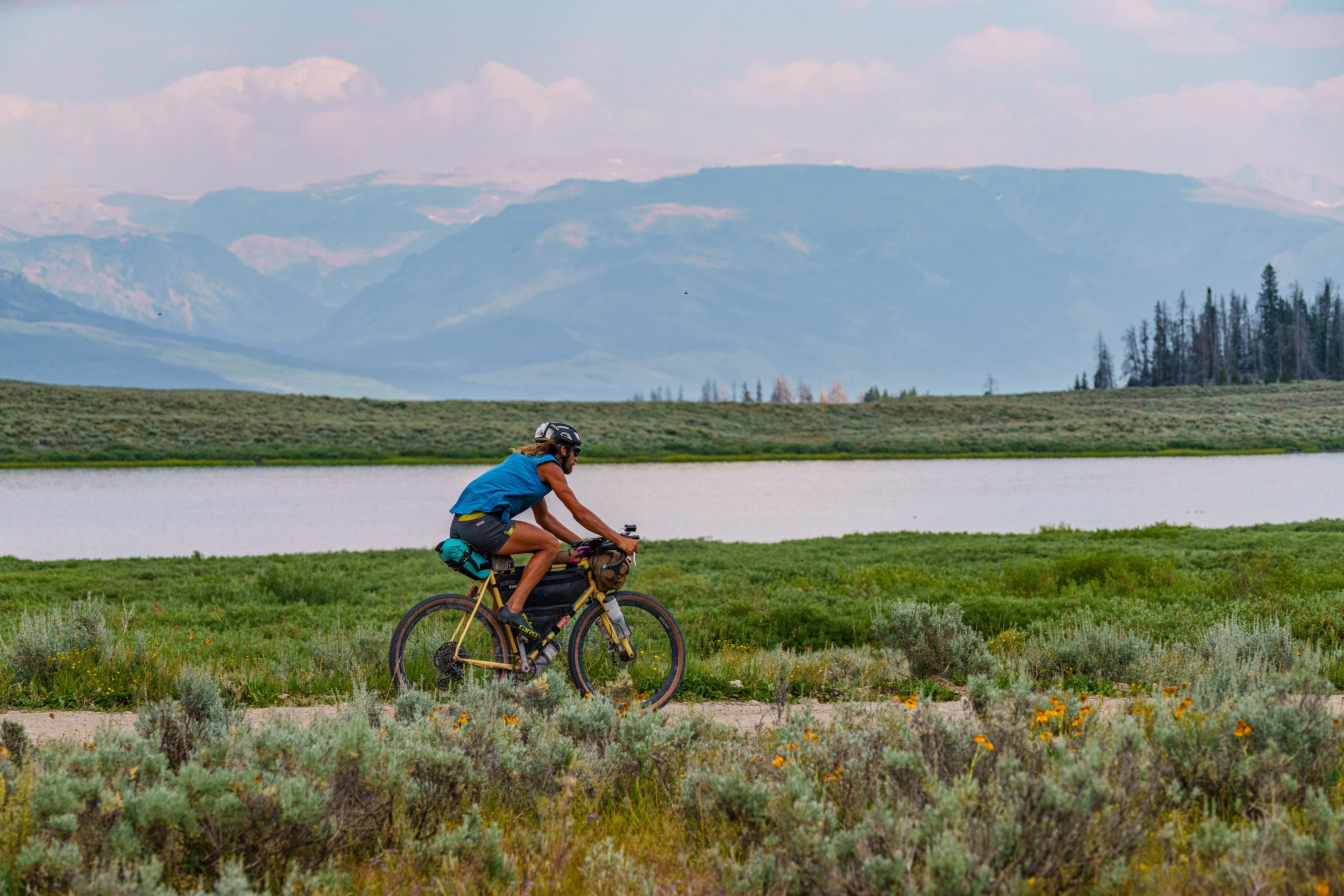
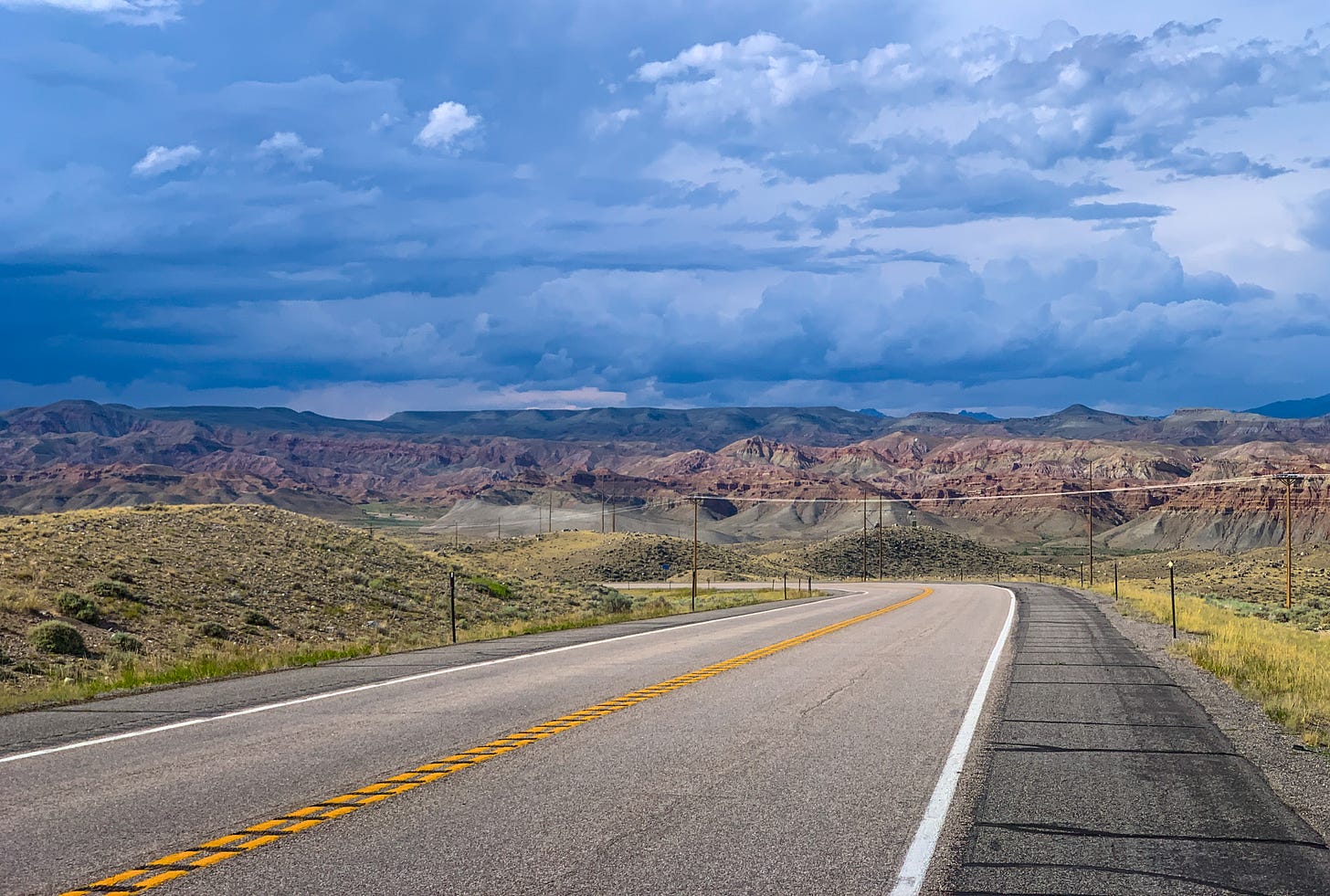
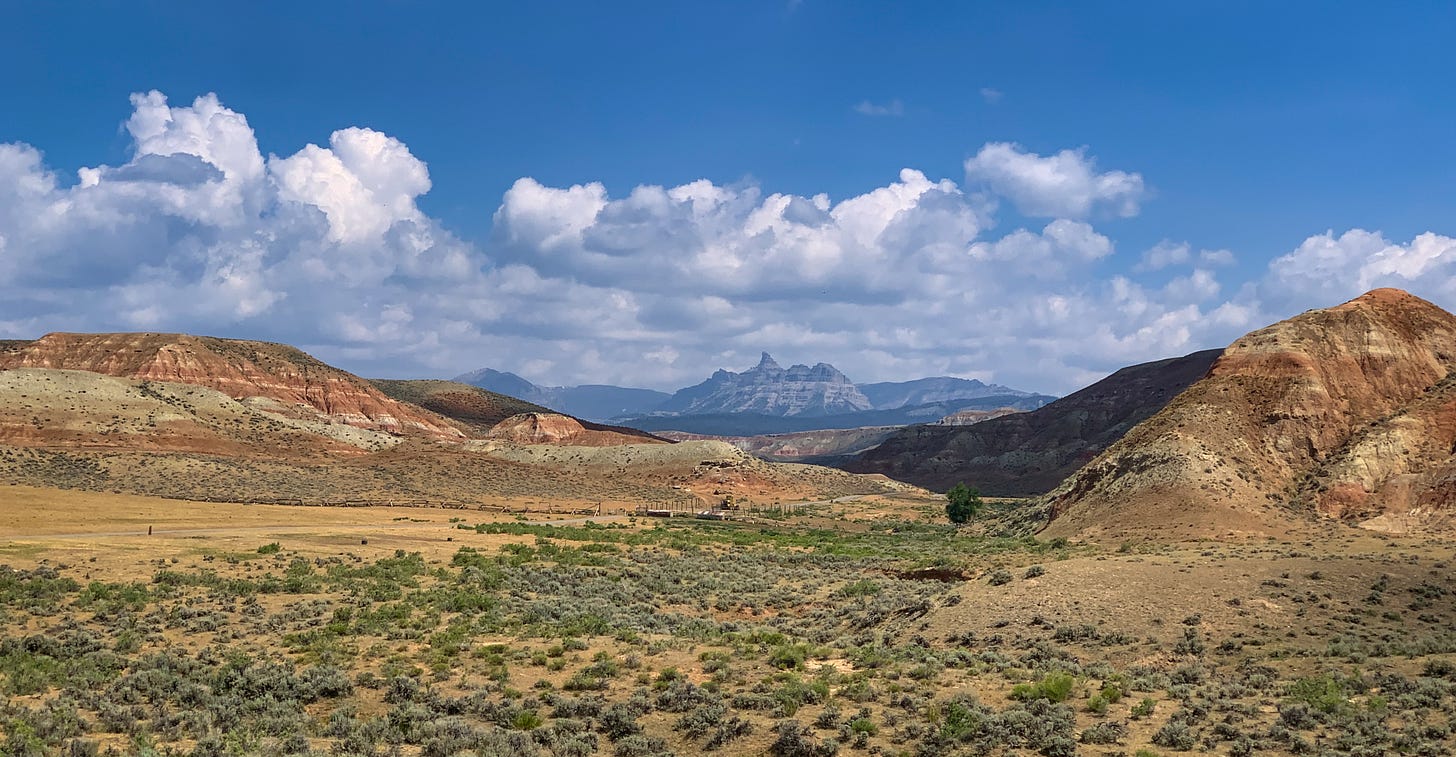
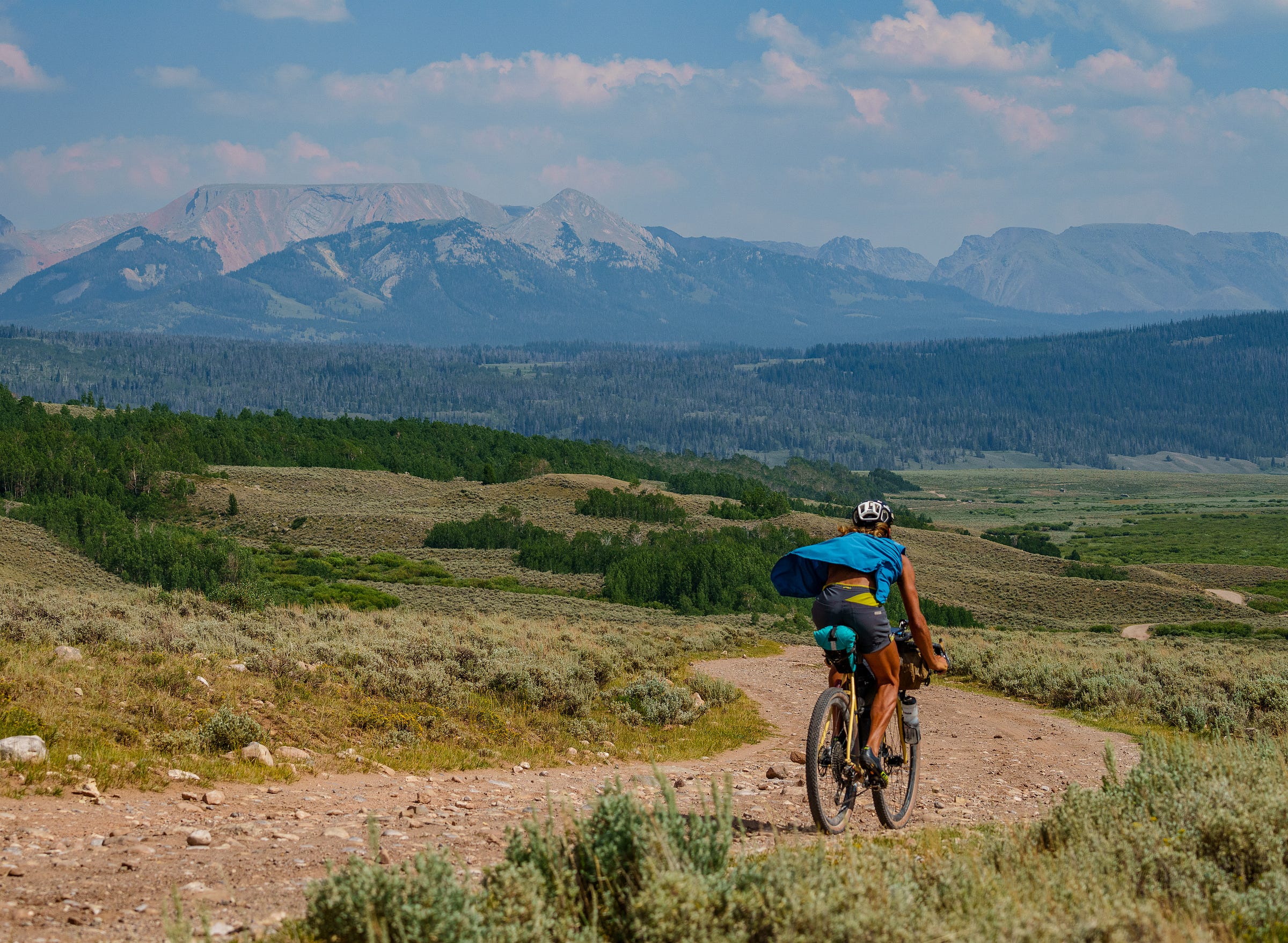
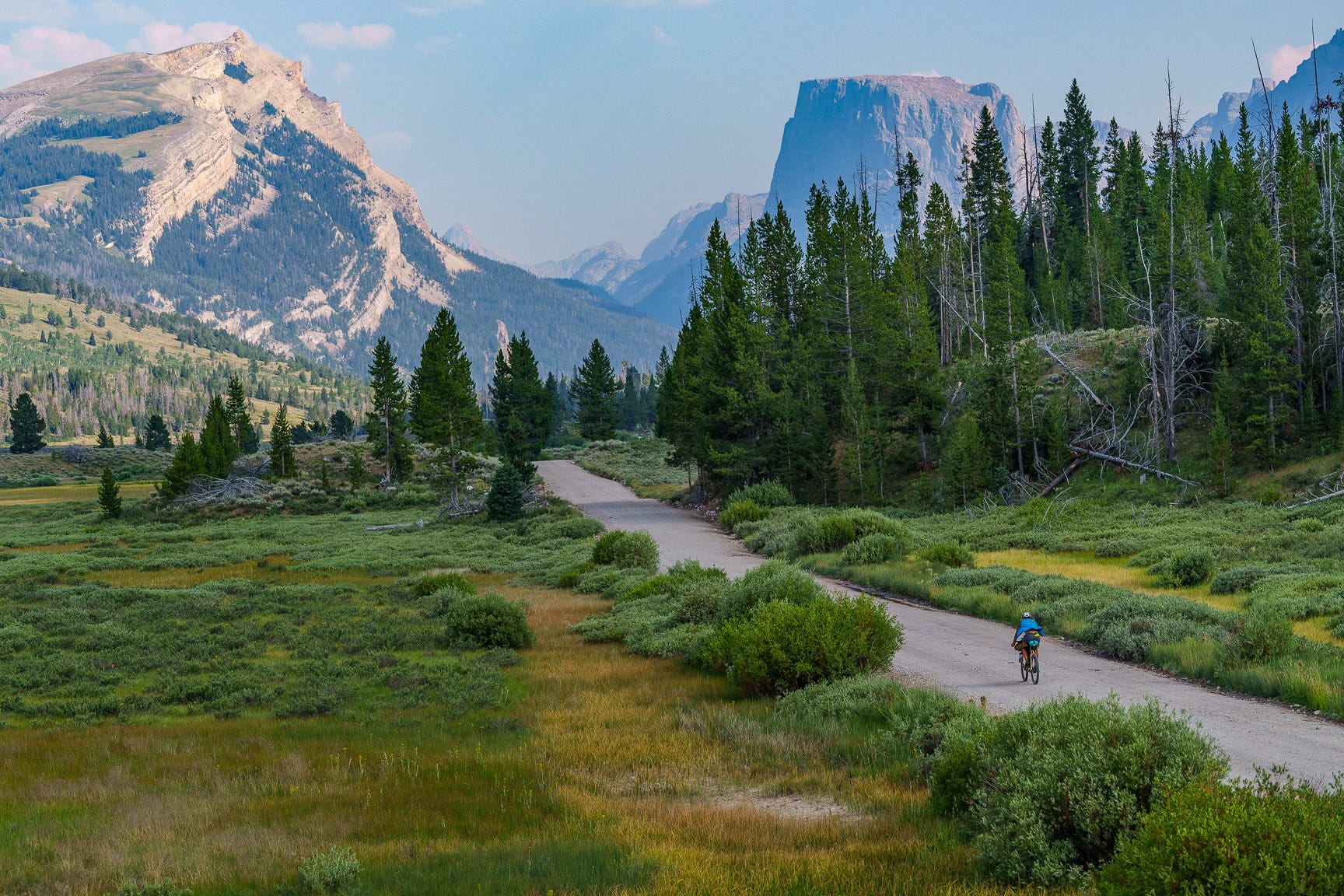
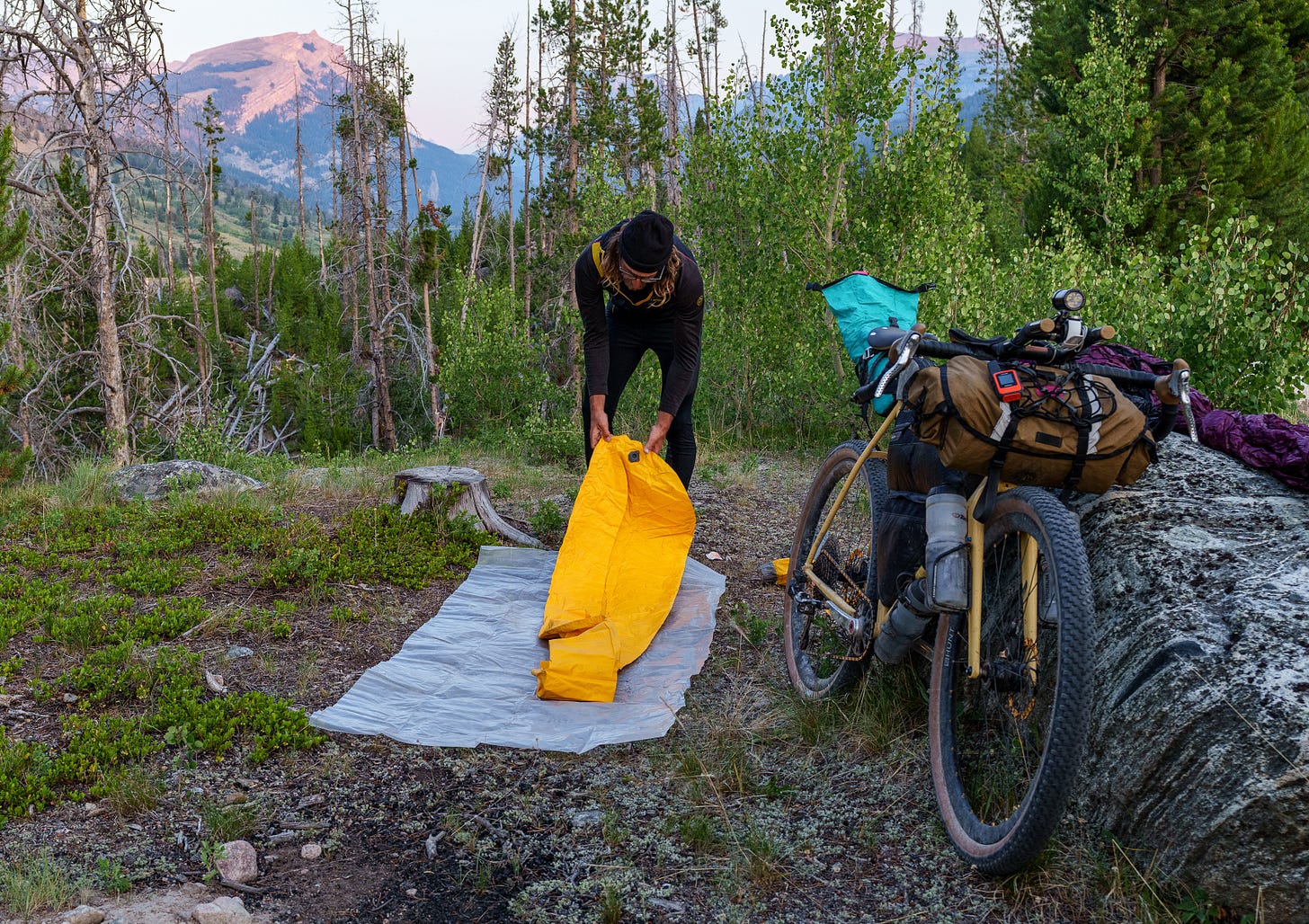
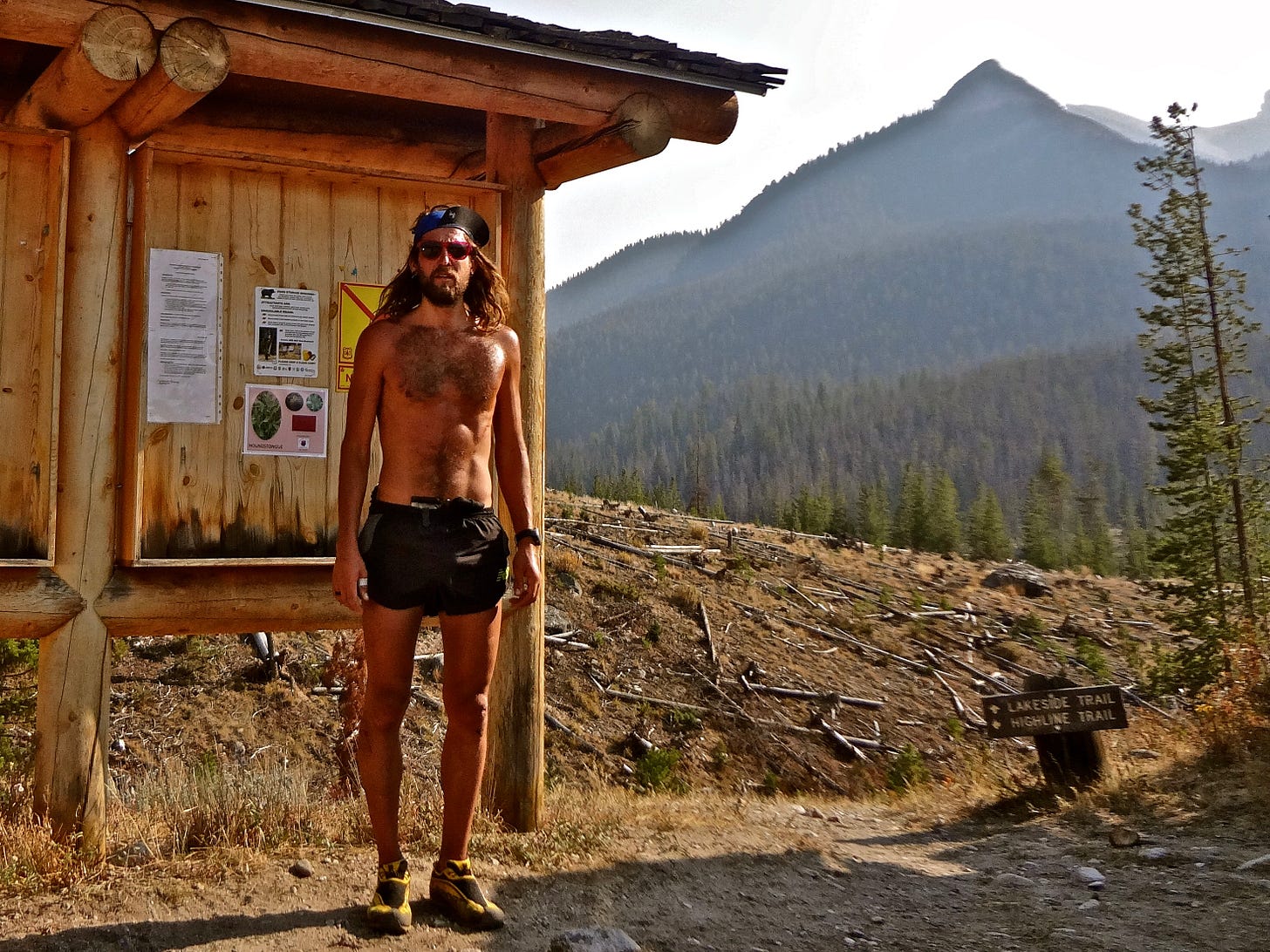
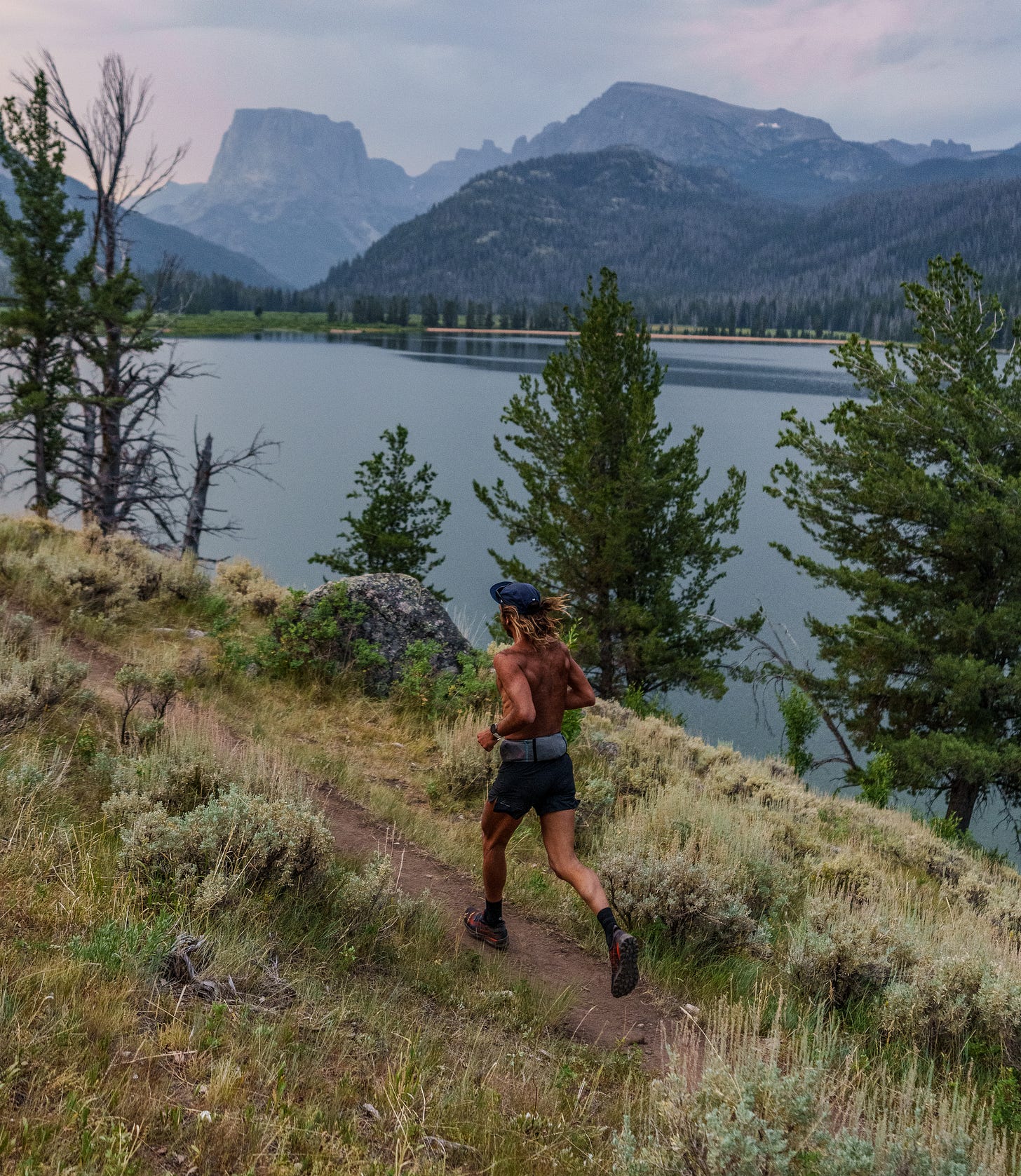
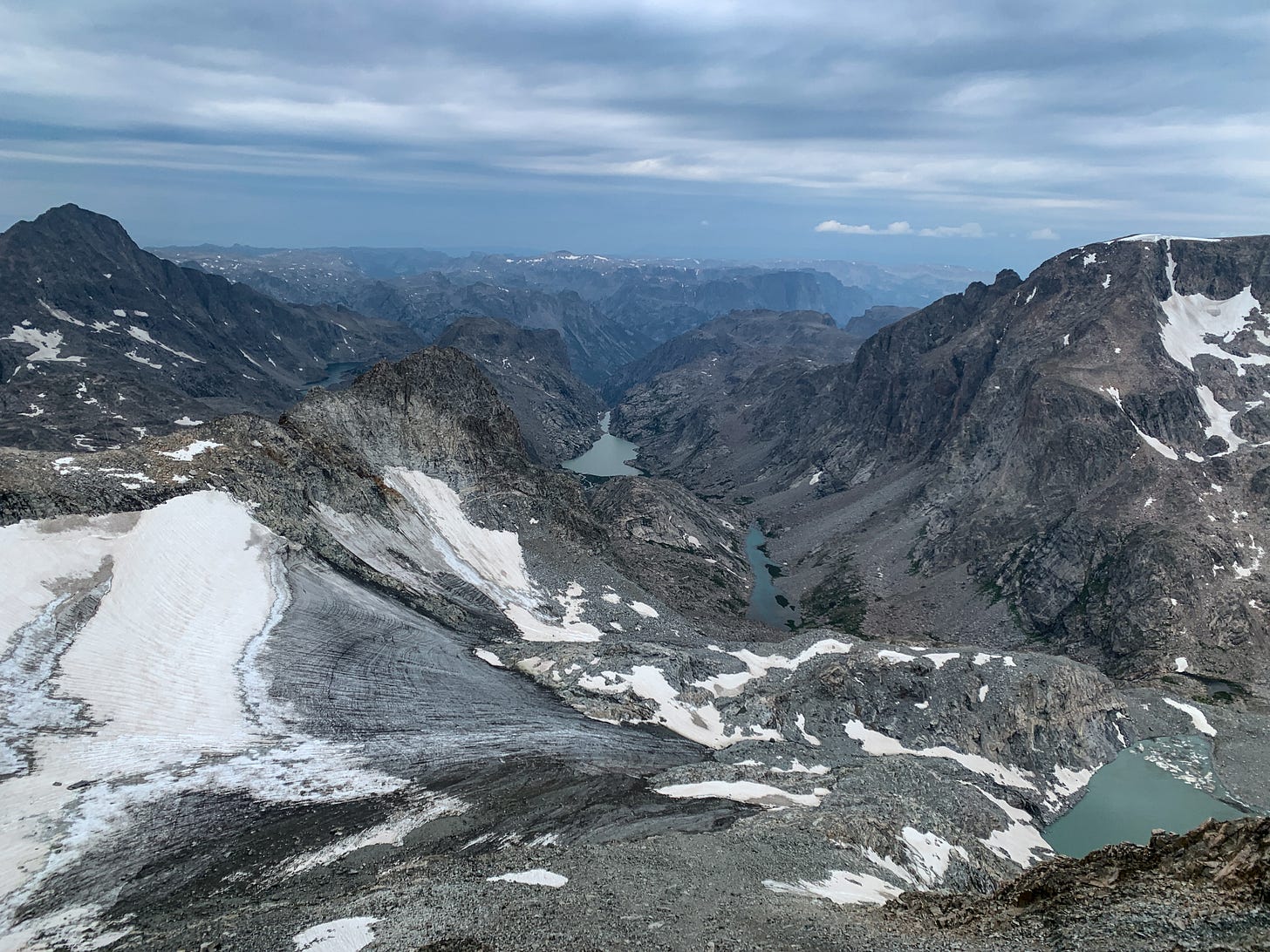
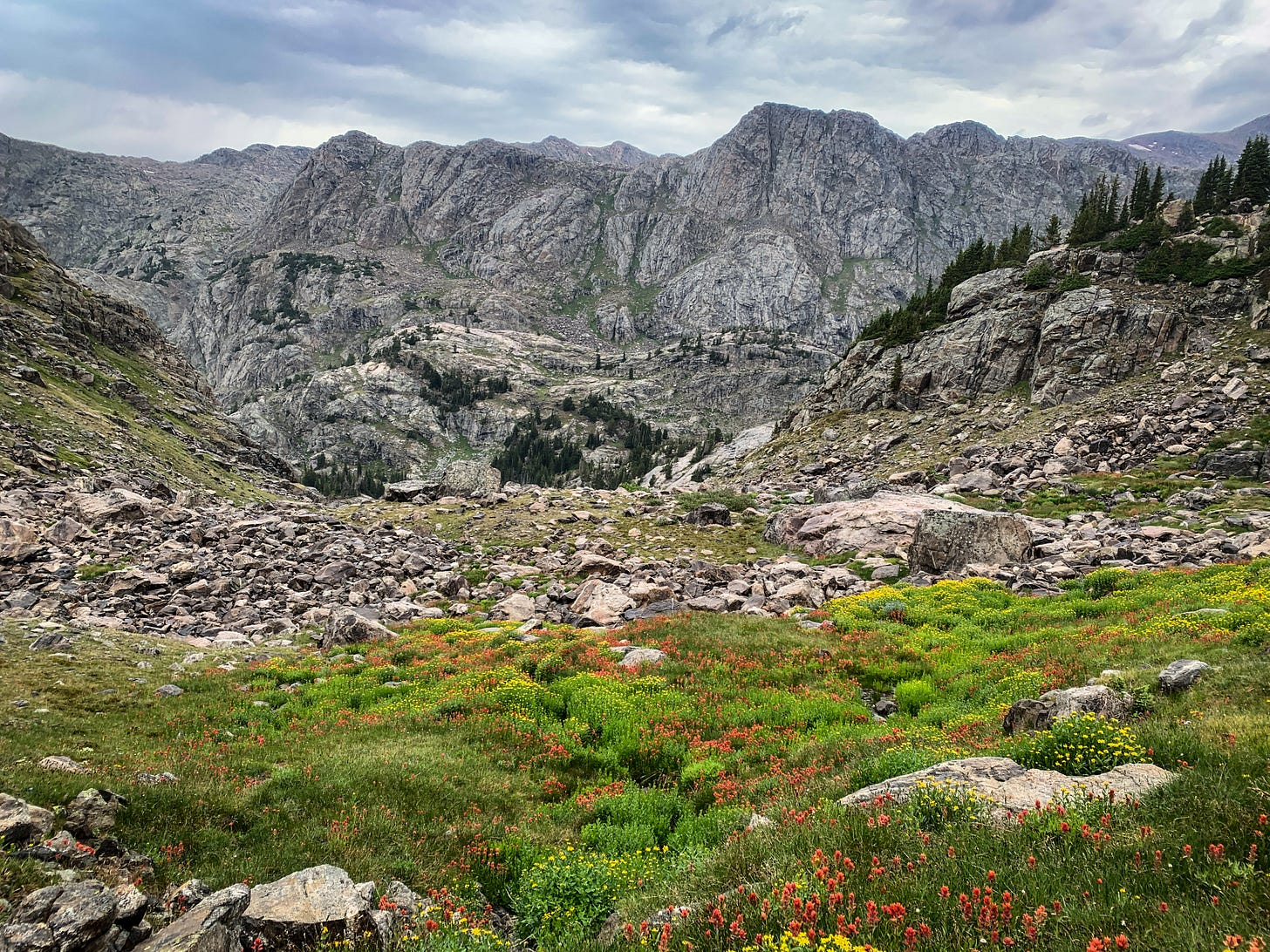
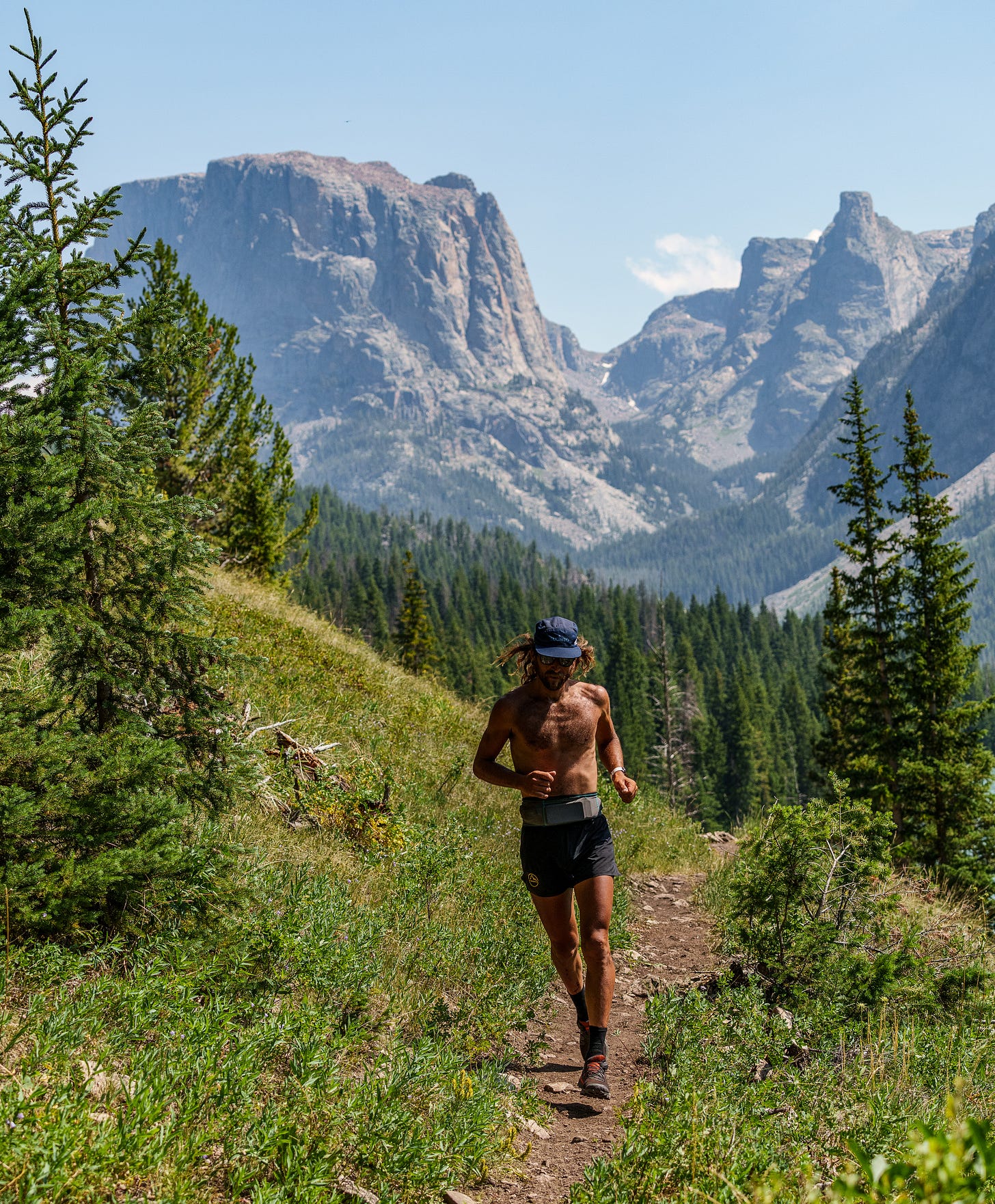
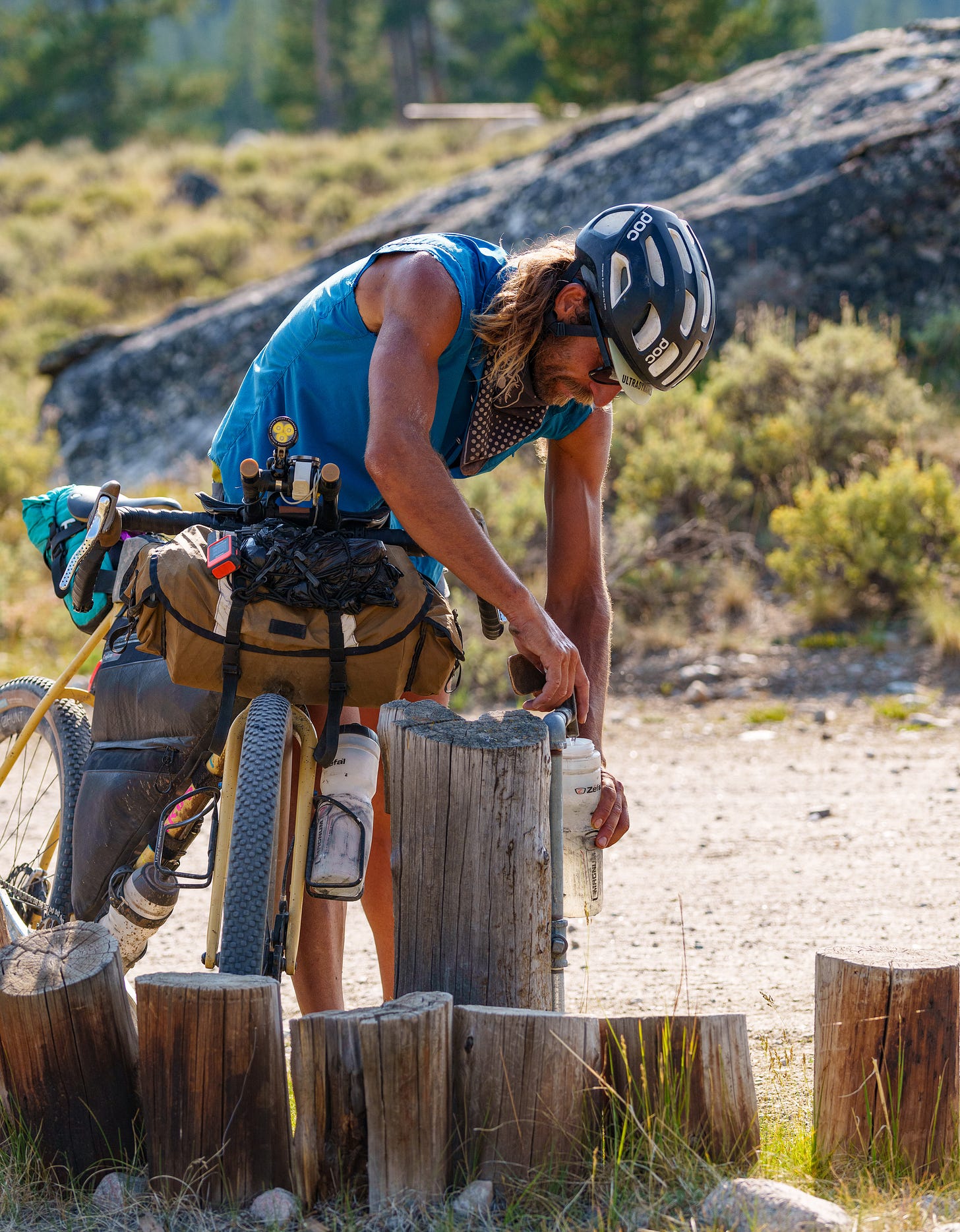

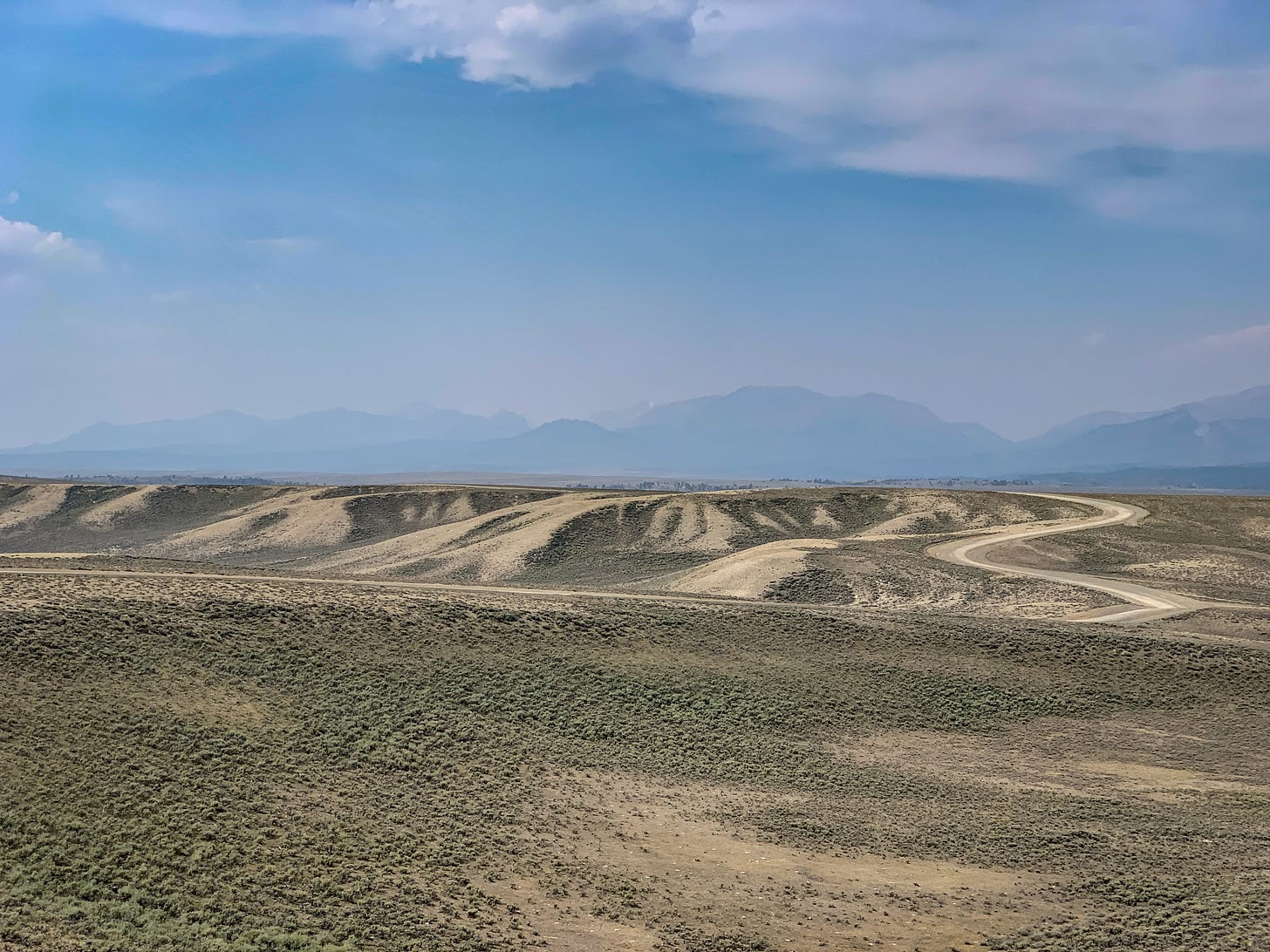
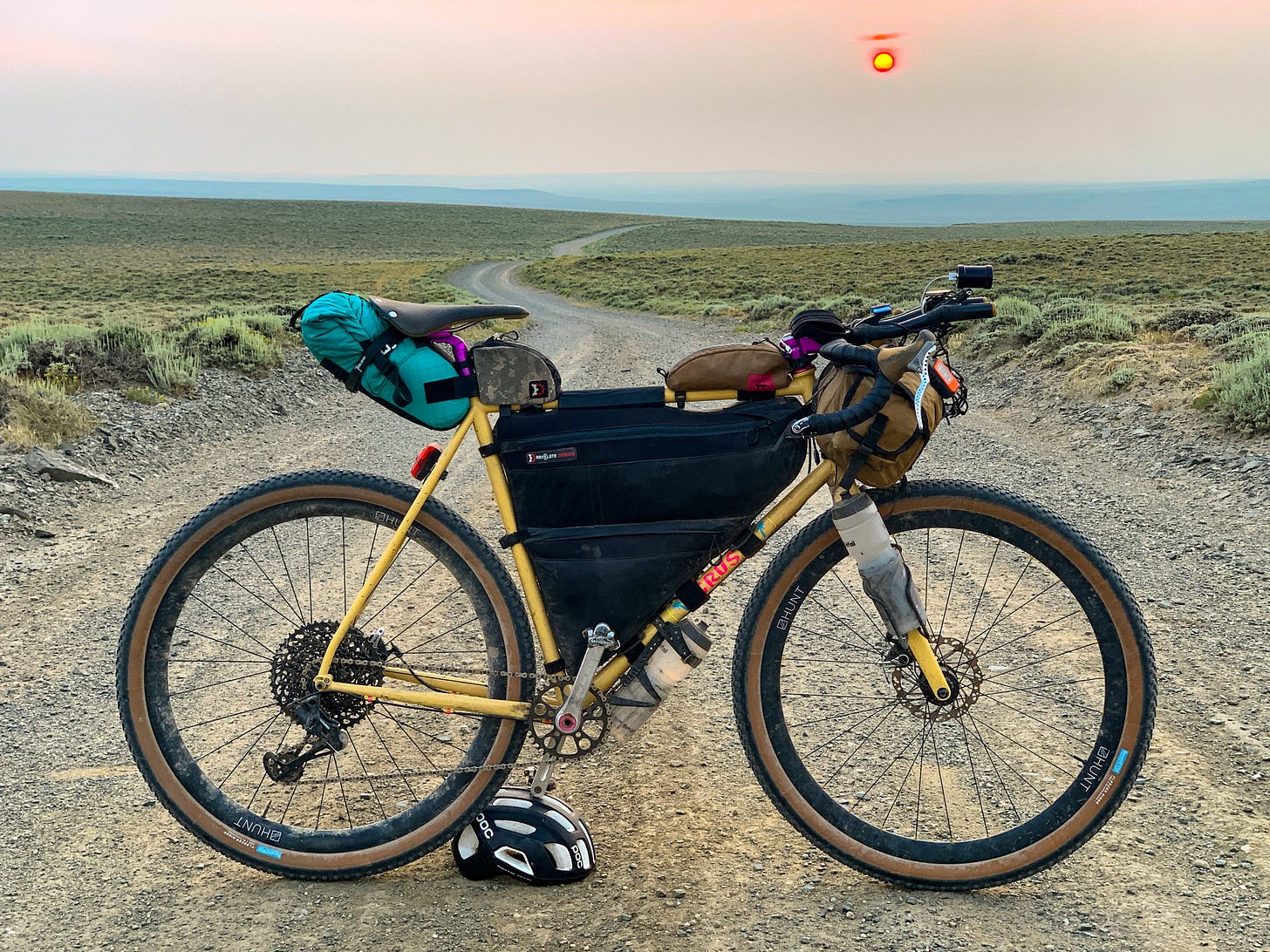

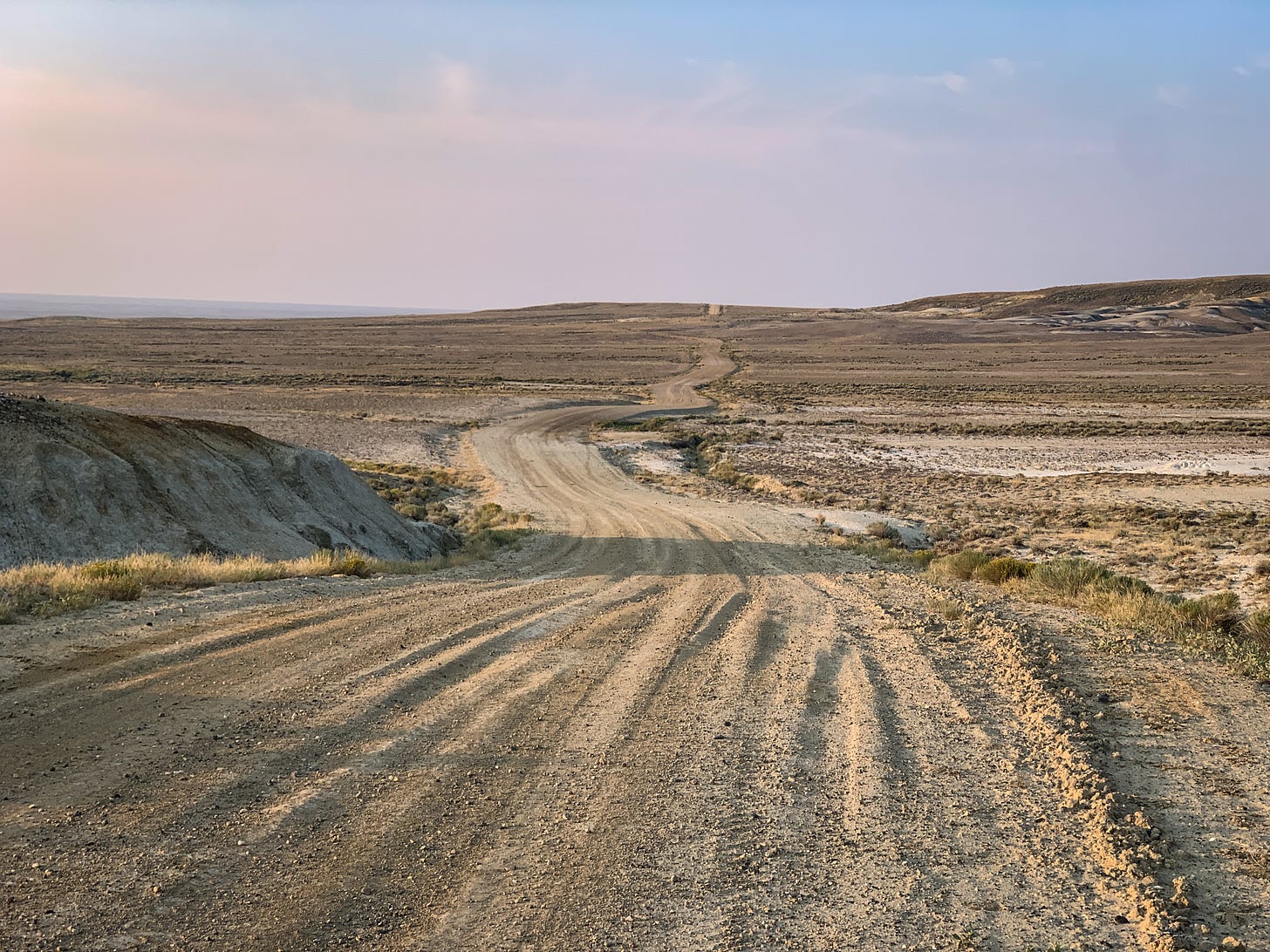
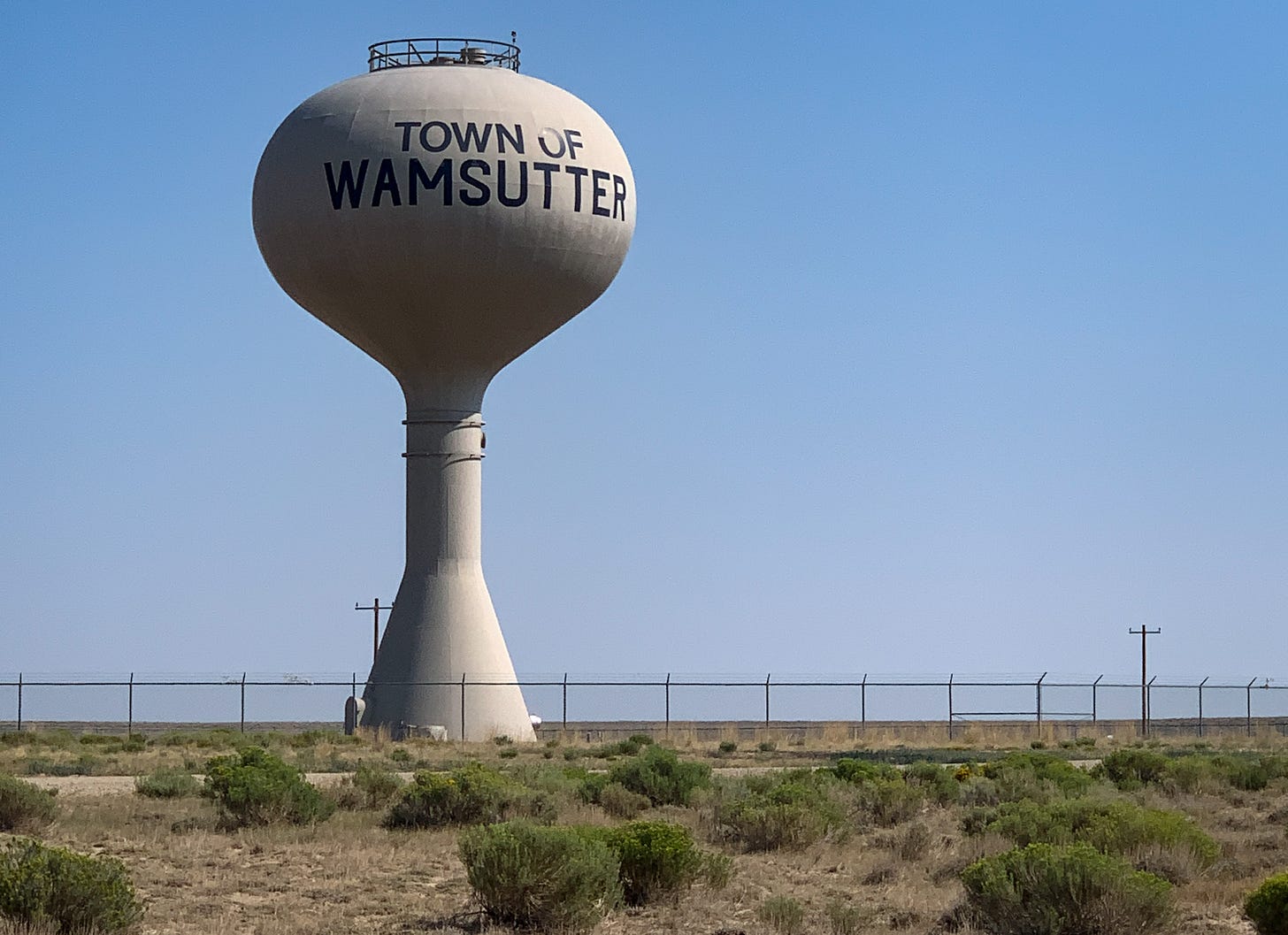
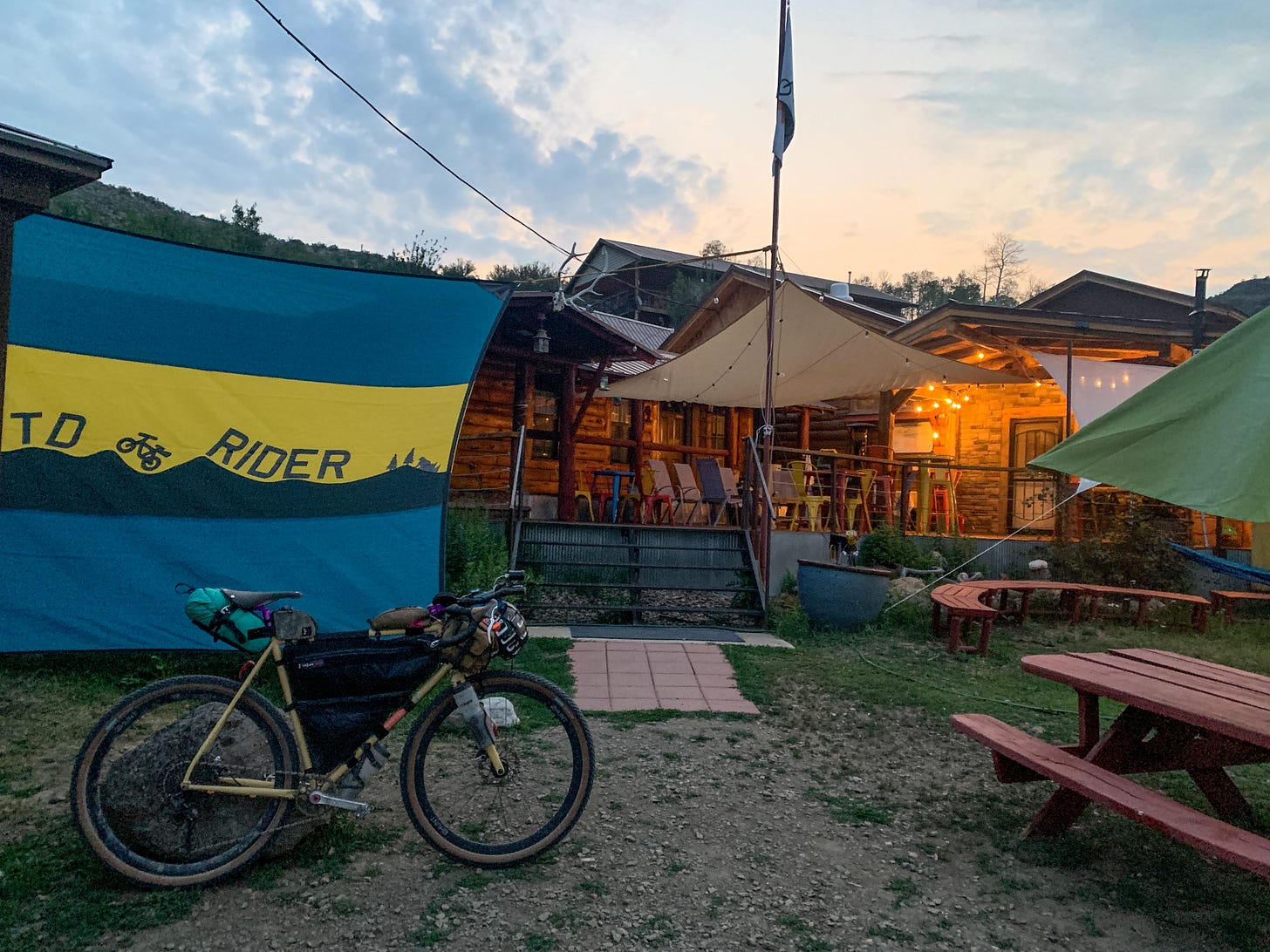
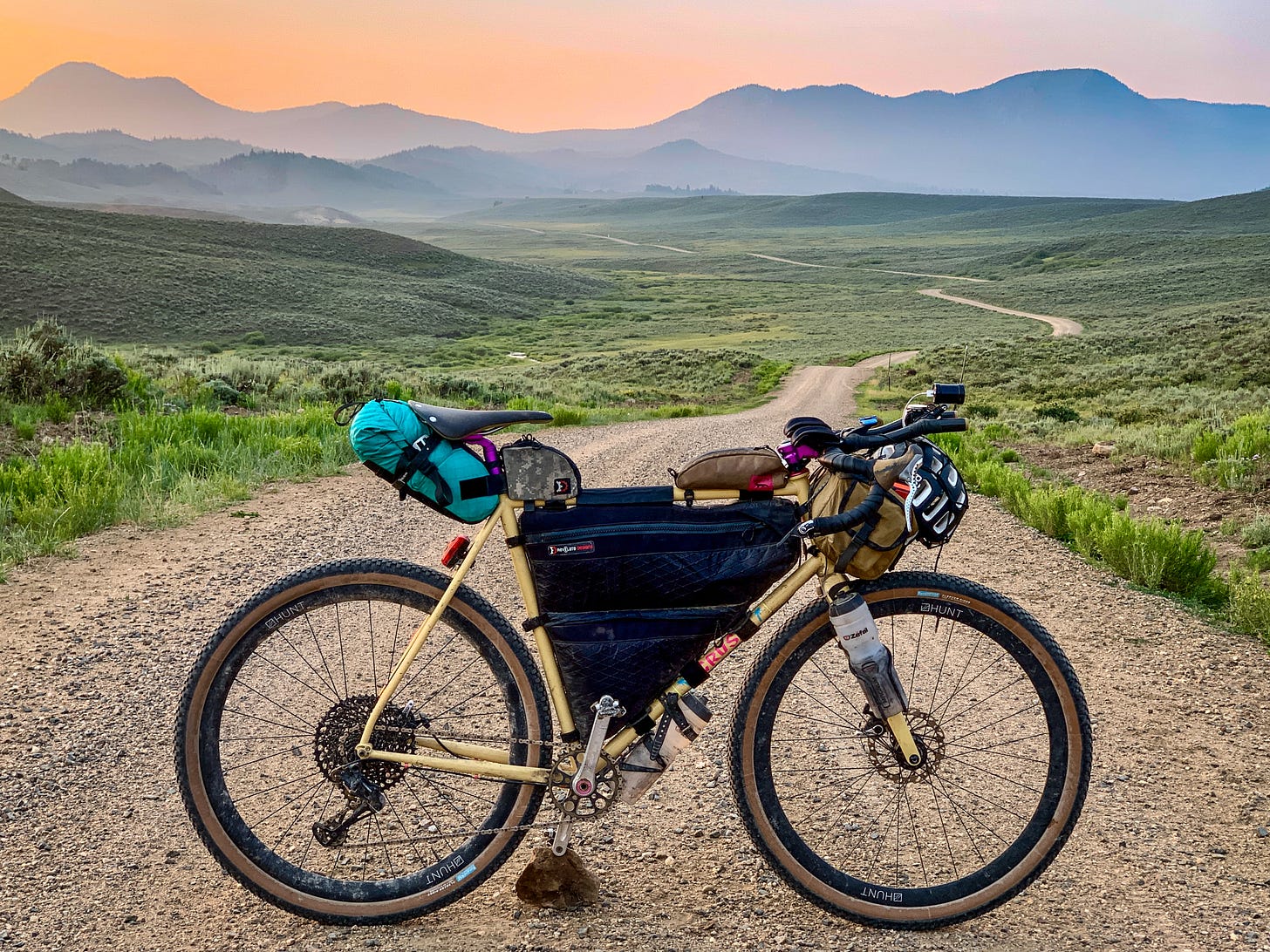
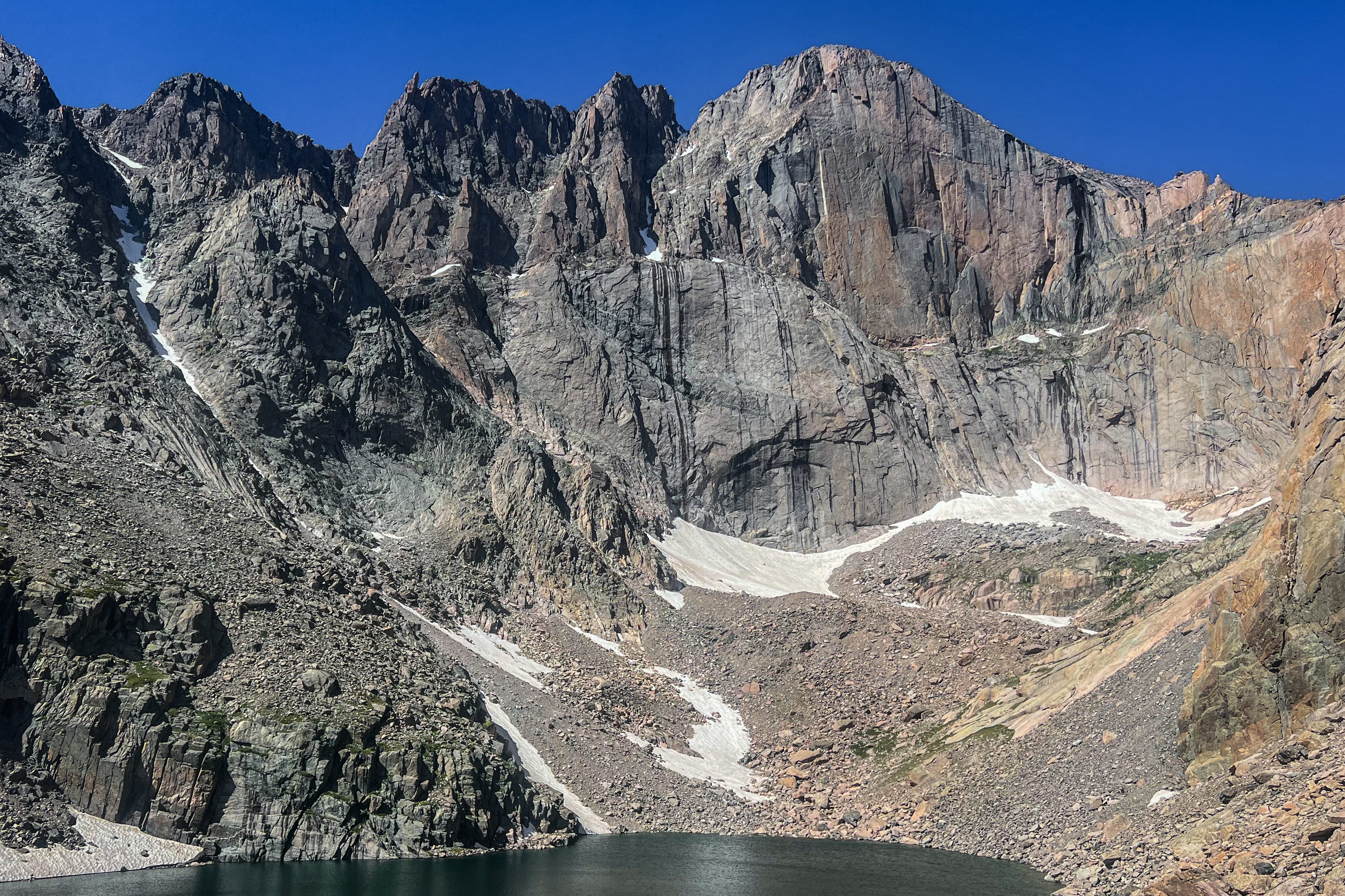
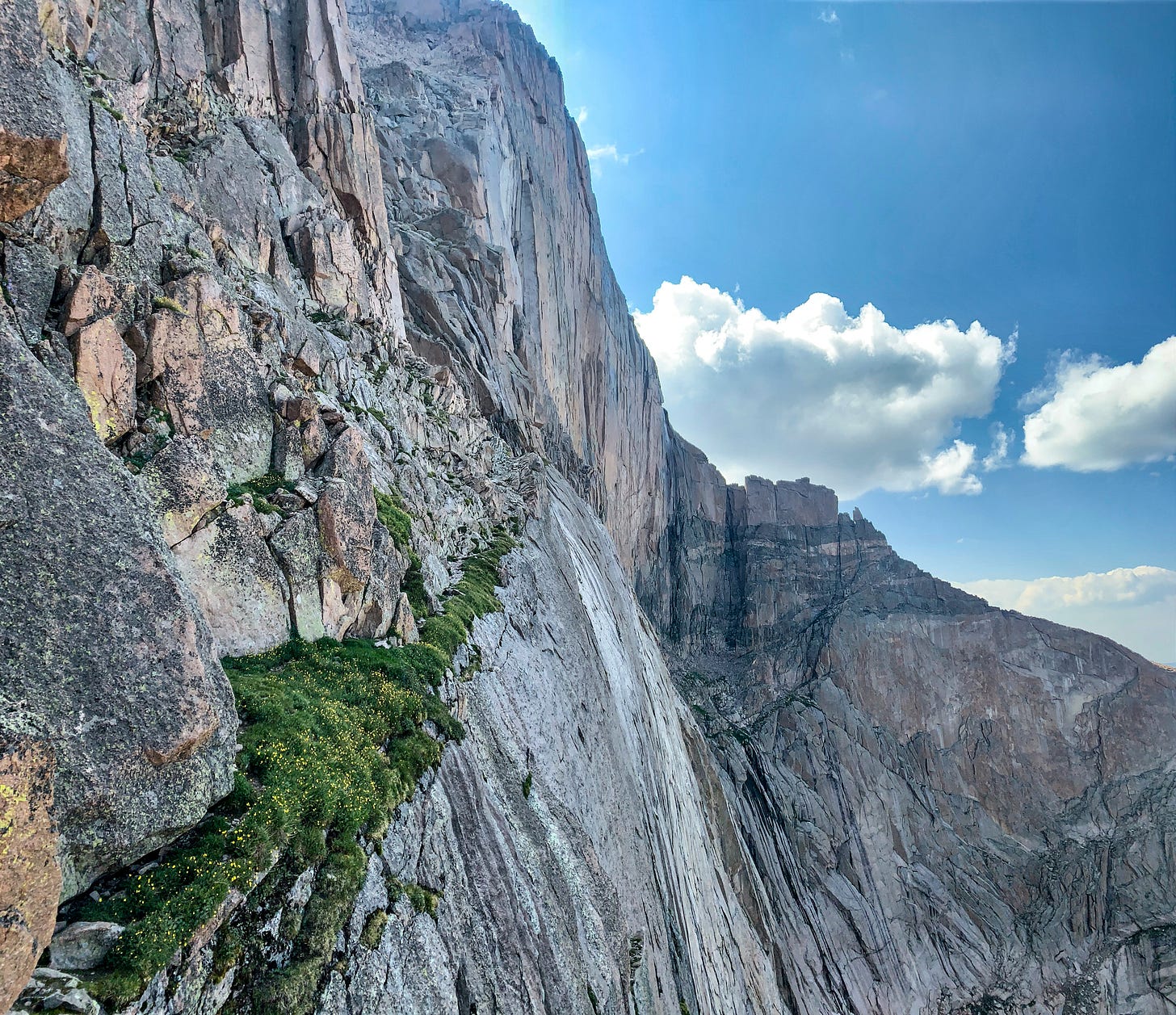
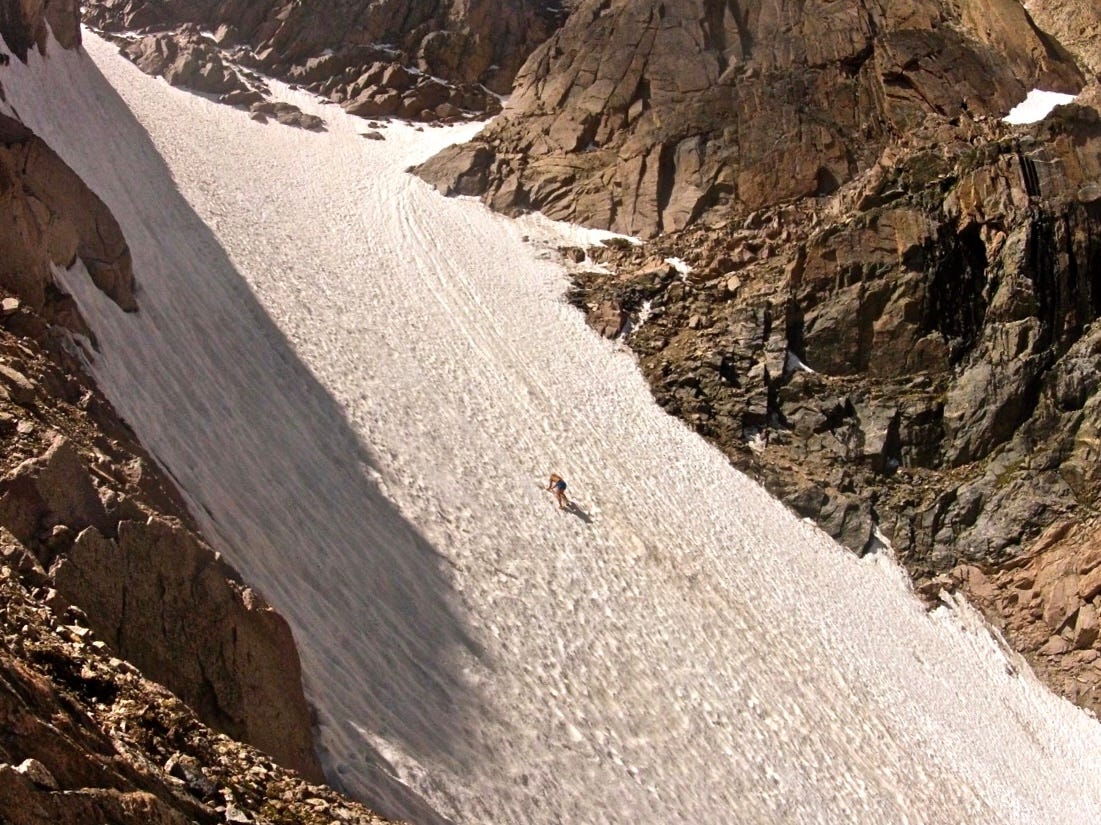
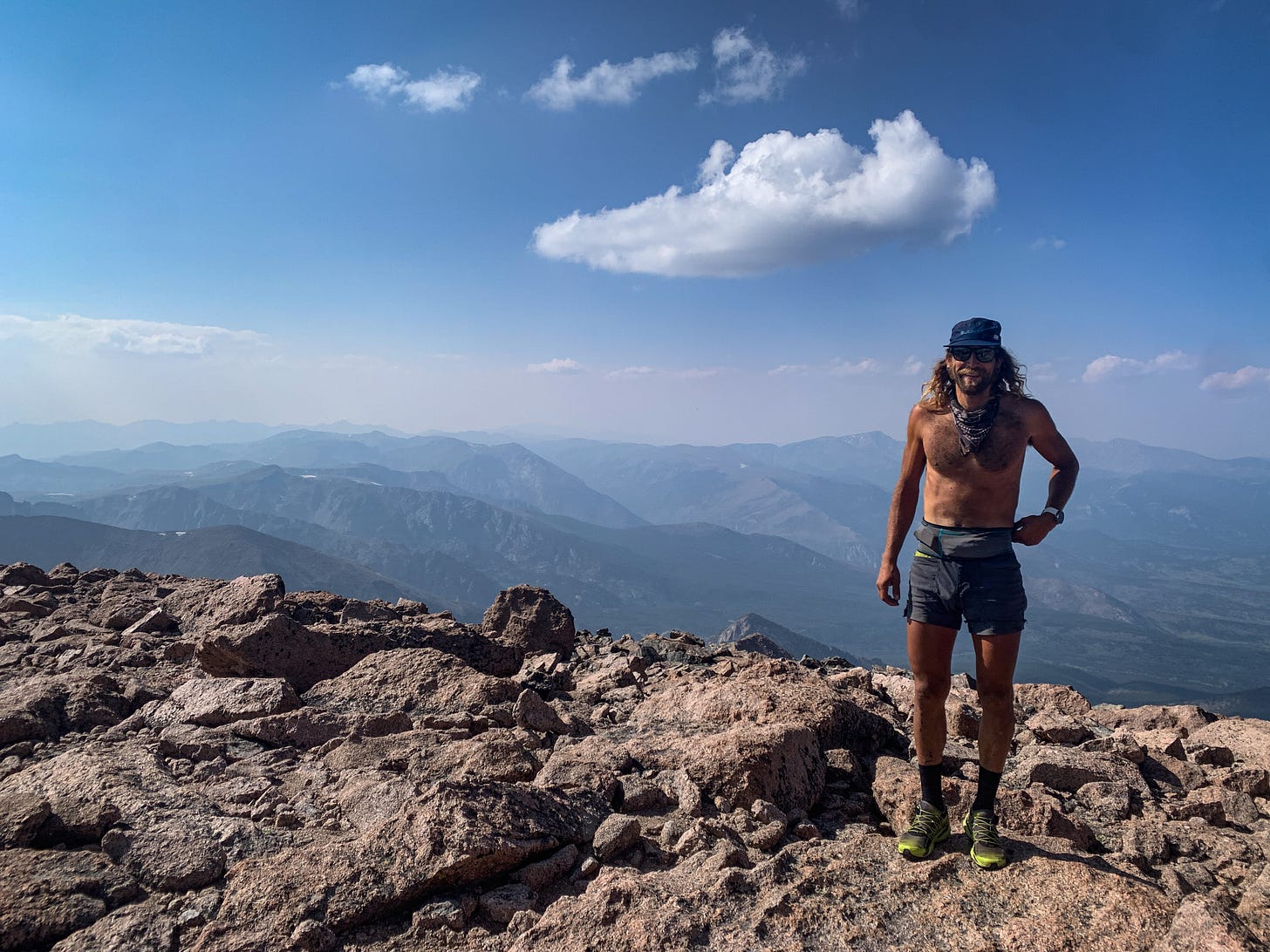
best installment of the series!
These 3 kept me up from my normal sleep time. Incredible trip and well written. Looking forward to more of your writing. You probably don’t need any motivation from me.. but keep it up man!